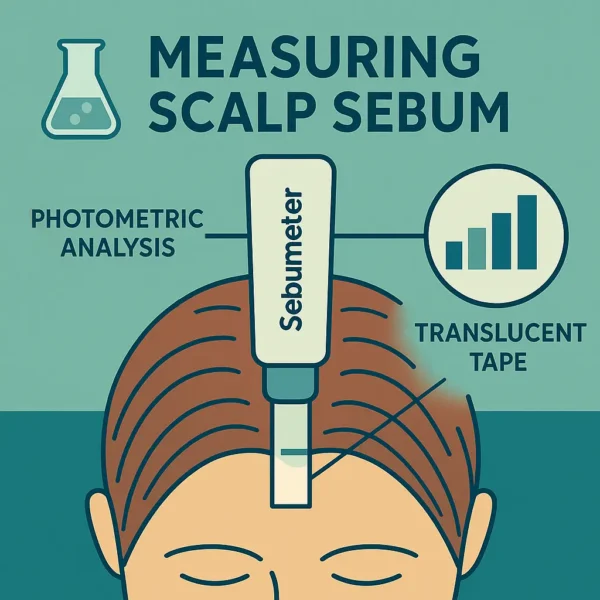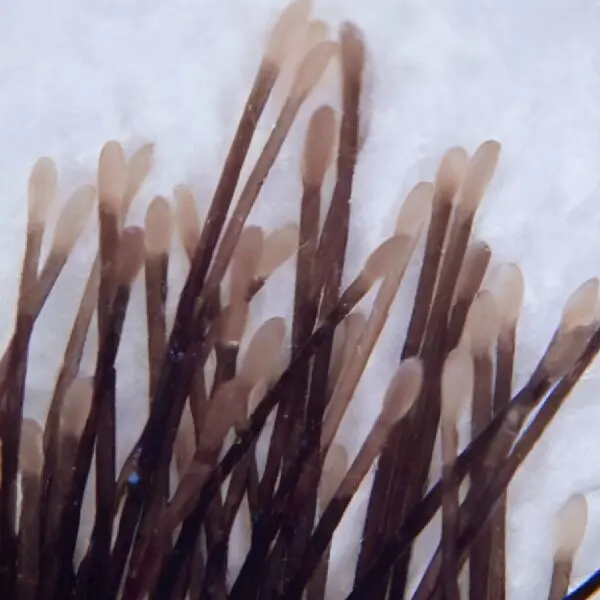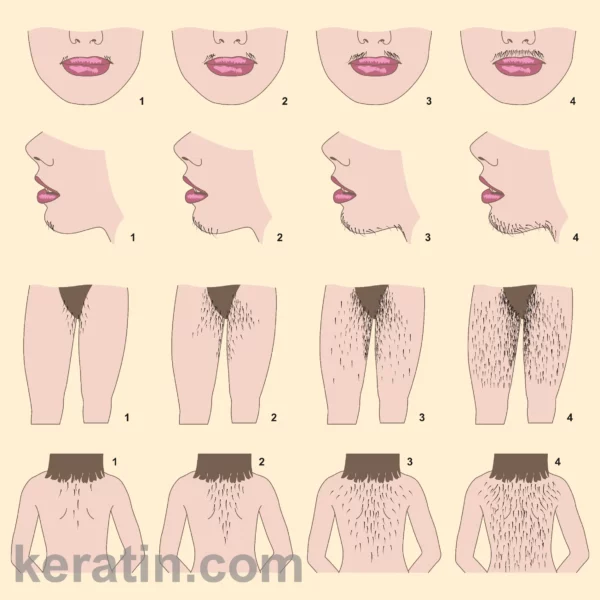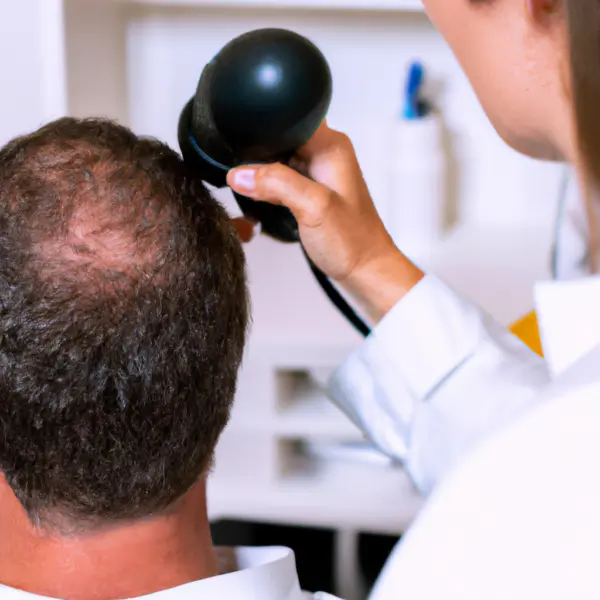Sebaceous glands are holocrine units that synthesise and excrete a complex lipid mixture – sebum – onto the surface of skin and hair. On the scalp, an optimum film of sebum lubricates shafts, reduces frictional damage and contributes to the epidermal barrier. Nevertheless, excessive production (seborrhoea) is linked to common disorders such as seborrhoeic dermatitis, dandruff and some phenotypes of androgenetic alopecia, whereas abnormally low output may accompany desquamative or inflammatory dermatoses. Because visual inspection of “greasiness” is subjective and influenced by hair length, density and cosmetic treatments, dermatologists have adopted quantitative methods – above all sebumetry – to obtain objective, reproducible data that support diagnosis, therapeutic monitoring and product development.
Biophysics of Sebum Secretion on the Scalp: Sebum originates in basal sebocytes that undergo lipid-laden holocrine rupture. Its excretion rate depends on gland size, local androgen signalling (notably dihydrotestosterone), enzymatic activity such as 5-α-reductase, and systemic factors including diet and retinoid status. Unlike facial skin, the hair canopy delays lateral spread of lipids, producing a characteristic “regreasing curve”: immediately after shampooing the surface is relatively lipid-free, followed by a quasi-linear accumulation over 24–72 h that eventually plateaus. Image-analysis studies using polymer films (Sebuprint®) confirm that these kinetics vary between individuals classified by self-perceived oiliness and by ethnic background (Gao et al., 2019). Hence, dynamic rather than single-time-point measurements may be most informative when evaluating interventions that claim to slow “regreasing”.
How Is Scalp Sebum Quantified? There are several ways to measure scalp sebum:
Sebumetry (Sebumeter® SM815 and related probes): This widely used technique presses a lipid-absorbing polymer tape, housed in a spring-loaded cassette, onto the scalp for 30 s. Sebum absorbed into the tape decreases its transparency; a built-in photometer then converts this optical change to lipid mass per unit area (µg cm⁻²) or to an arbitrary scale of 1–100. The procedure is portable, painless and yields results within seconds, which explains its popularity in both clinics and cosmetic laboratories.Sebuprint® film analysis: Here, a larger polymer strip is parted through the hair along a defined line. After application, high-resolution images are analysed to map the spatial distribution of sebum and to calculate regreasing slopes. Although more labour-intensive, the method captures the dynamic spread of lipids along shafts and follicles – a parameter missed by point-sampling techniques.Solvent extraction followed by gas chromatography–mass spectrometry (GC-MS): Organic solvents strip lipids from a defined scalp area; the extracts are subsequently separated and quantified with GC-MS, yielding detailed lipid profiles (squalene, free fatty acids, wax esters and cholesterol esters). The technique remains the gold standard for compositional studies but is unsuitable for routine chair-side use because it is invasive, time-consuming and requires specialised instrumentation.Vibrational spectroscopies (Raman and mid-infrared): In vivo Raman or IR probes detect characteristic vibrational modes of lipid molecules without physical sampling. They eliminate consumables and contact artefacts, yet heavy capital costs for the machinery used and hair-related signal scattering currently limit routine application. Rationale for choosing sebumetry: Among thesoptions available, sebumetry offers the best compromise of accuracy, repeatability, speed and cost. Early validation work by Simpson and Martin (1983) demonstrated intra-individual coefficients of variation below 10 % when pressure, temperature (20–22 °C) and post-wash interval were standardised, and the European Expert Group on Efficacy Measurement of Cosmetics and Other Topical Products (EEMCO) later enshrined the probe as the reference method for assessing both casual sebum level (CSL) and sebum excretion rate (SER).
Practical Considerations Unique to Scalp Measurements: There are various issues to consider:
Hair interference. Operators part the hair – typically at the mid-parietal or vertex line – to ensure flat contact. Spring-loaded devices minimise variability in applied pressure.Post-cleansing interval. Whereas facial CSL stabilises within three hours, the scalp may require 48–72 h; most protocols therefore stipulate at least 48 h since the last shampoo for baseline readings.Anatomical site. Sebaceous density is highest on the vertex and parietal scalp and lowest occipitally. Longitudinal follow-up must sample the same site each visit.Environmental control. Sebum output follows diurnal rhythms and rises with ambient temperature and humidity. Patients should acclimatise for 15 min in a controlled environment, and serial readings are best taken at the same time of day.Exogenous contamination. Hair oils, leave-in conditioners or occupational greases confound readings; patients should avoid such products for at least 24 h before assessment. Why Would a Dermatologist Measure Scalp Sebum? There are several reasons why dermatologists might look at sebum production from scalp skin:
Seborrhoeic dermatitis and dandruff: These disorders exhibit erythema and flaking that correlate poorly with clinical “oiliness”. Malassezia yeasts depend on triglyceride substrates; therefore, quantifying sebum provides an indirect measure of the nutrient load available to this lipophilic microbiota. Baseline CSL allows objective grading, and serial measurements can track response to antifungal agents (e.g., ketoconazole) or anti-inflammatories (e.g., calcineurin inhibitors).Androgenetic alopecia (AGA): Histological studies show that sebaceous glands enlarge around miniaturising follicles. Suzuki et al. (2021) demonstrated distinct clusters of microbial taxa and sebum lipid species in Japanese men with AGA compared with controls, implying that quantitative sebometry could stratify phenotypes or serve as a surrogate marker for the efficacy of systemic anti-androgens such as finasteride or topical 5-α-reductase inhibitors.Monitoring sebosuppressive pharmacotherapy: Low-dose oral isotretinoin (10–20 mg day⁻¹) markedly suppresses sebaceous gland activity. Yetkin et al. (2016) showed that a ≥20 % reduction in scalp CSL after eight weeks correlated with subjective improvements in greasiness and quality of life. Objective readings help clinicians fine-tune dosage, predict relapse and counsel patients on expected timelines.Substantiating cosmetic claims: Regulatory agencies and advertising standards bodies increasingly request quantitative endpoints to support “oil-control” or “anti-regreasing” claims for shampoos, conditioners and leave-in products. Sebumetry, recorded at defined intervals post-wash, has become the default primary endpoint in such consumer studies owing to its speed and user-friendliness.Nutraceutical and microbiome-modulating interventions: A randomised, placebo-controlled trial of the polyphenol-rich Ayurvedic formulation Triphala reported a significant reduction in scalp CSL after eight weeks of oral supplementation. Without objective sebum data, disentangling true physiological benefit from participant expectancy would have been impossible.Occupational and forensic dermatology: Quantitative sebum data can help differentiate endogenous hyperseborrhoea from exogenous oil contamination in individuals exposed to mineral or synthetic lubricants at work, thereby informing medico-legal assessments. Interpreting Sebometric Data: Absolute values on the scalp vary widely – typically 50–200 µg cm⁻² at 48 h post-wash in healthy adults – driven by genetics, age, sex and climate. Consequently, dermatologists focus on within-subject change rather than cross-sectional thresholds. A reduction or increase of ≥20 % from baseline is generally regarded as clinically relevant, although some cosmetic studies use stricter cut-offs (e.g., 15 %) to claim efficacy. When treatment effects are modest, combining CSL with patient-reported outcomes (pruritus, perceived greasiness) provides a more holistic picture of therapeutic benefit.
Limitations and Future Directions: Measuring scalp sebum is still a technique under active development:
Sampling artefacts. Hair shafts wick lipids away from the contact area, potentially under-estimating true secretion. Novel probe caps with hair-separating prongs or suction assistance are under development to improve accuracy.Temporal resolution. Current devices provide point estimates. Integrating miniaturised sensors into wearable headbands could enable continuous monitoring of regreasing dynamics under real-life conditions.Composition versus quantity. Sebumetry quantifies total lipid mass but not composition. Integrating tape sampling with downstream liquid chromatography–mass spectrometry can reveal compositional shifts, yet cost and analytical complexity are limiting. Advances in fibre-optic Raman spectroscopy hold promise for real-time compositional profiling in situ.Standardisation gaps. Although EEMCO guidelines exist, inter-laboratory variability persists. International efforts to harmonise protocols – analogous to spirometry standards in respiratory medicine – would enhance comparability of clinical trials. Conclusion: Objective measurement of scalp sebum has transitioned from cumbersome solvent extractions to swift, user-friendly photometric probes. Routine sebumetry equips dermatologists and researchers with a sensitive biomarker that (i) clarifies the role of seborrhoea in diverse scalp disorders, (ii) enables evidence-based monitoring of pharmacological and cosmetic interventions, and (iii) deepens mechanistic understanding of the lipid–microbe–inflammation axis. As sensing hardware miniaturises and analytic pipelines converge, quantitative sebum profiling is poised to become as indispensable to scalp-focused dermatology as densitometry is to bone health.
Bibliography
11711645 {11711645:KFAIIQTX},{11711645:G62PKMT7},{11711645:YAF4X6XJ},{11711645:I8VGUTJY},{11711645:DRHCEPBS},{11711645:SJ6UPVBP},{11711645:VVAFCXV8},{11711645:WS9KQXPF},{11711645:VZB6PW6S},{11711645:BFTTZQ36},{11711645:DLG5I6A9},{11711645:LQRFIH8X},{11711645:4RMN4T5J},{11711645:27LLC9AN},{11711645:696LE293},{11711645:HLTG2VE5},{11711645:3ESIDL3X},{11711645:2UB3VNG6},{11711645:AVK87LPI},{11711645:CH9Y4T2B},{11711645:2KDHCBQ4} 1 vancouver 50 date asc 1931 https://www.keratin.com/wp-content/plugins/zotpress/ %7B%22status%22%3A%22success%22%2C%22updateneeded%22%3Afalse%2C%22instance%22%3Afalse%2C%22meta%22%3A%7B%22request_last%22%3A0%2C%22request_next%22%3A0%2C%22used_cache%22%3Atrue%7D%2C%22data%22%3A%5B%7B%22key%22%3A%22BFTTZQ36%22%2C%22library%22%3A%7B%22id%22%3A11711645%7D%2C%22meta%22%3A%7B%22creatorSummary%22%3A%22Burton%20et%20al.%22%2C%22parsedDate%22%3A%221973-03%22%2C%22numChildren%22%3A0%7D%2C%22bib%22%3A%22%26lt%3Bdiv%20class%3D%26quot%3Bcsl-bib-body%26quot%3B%20style%3D%26quot%3Bline-height%3A%201.35%3B%20%26quot%3B%26gt%3B%5Cn%20%20%26lt%3Bdiv%20class%3D%26quot%3Bcsl-entry%26quot%3B%20style%3D%26quot%3Bclear%3A%20left%3B%20%26quot%3B%26gt%3B%5Cn%20%20%20%20%26lt%3Bdiv%20class%3D%26quot%3Bcsl-left-margin%26quot%3B%20style%3D%26quot%3Bfloat%3A%20left%3B%20padding-right%3A%200.5em%3B%20text-align%3A%20right%3B%20width%3A%201em%3B%26quot%3B%26gt%3B1.%26lt%3B%5C%2Fdiv%26gt%3B%26lt%3Bdiv%20class%3D%26quot%3Bcsl-right-inline%26quot%3B%20style%3D%26quot%3Bmargin%3A%200%20.4em%200%201.5em%3B%26quot%3B%26gt%3BBurton%20JL%2C%20Cartlidge%20M%2C%20Cartlidge%20NE%2C%20Shuster%20S.%20Sebum%20excretion%20in%20Parkinsonism.%20Br%20J%20Dermatol.%201973%20Mar%3B88%283%29%3A263%26%23x2013%3B6.%26lt%3B%5C%2Fdiv%26gt%3B%5Cn%20%20%20%26lt%3B%5C%2Fdiv%26gt%3B%5Cn%26lt%3B%5C%2Fdiv%26gt%3B%22%2C%22data%22%3A%7B%22itemType%22%3A%22journalArticle%22%2C%22title%22%3A%22Sebum%20excretion%20in%20Parkinsonism%22%2C%22creators%22%3A%5B%7B%22creatorType%22%3A%22author%22%2C%22firstName%22%3A%22J.%20L.%22%2C%22lastName%22%3A%22Burton%22%7D%2C%7B%22creatorType%22%3A%22author%22%2C%22firstName%22%3A%22M.%22%2C%22lastName%22%3A%22Cartlidge%22%7D%2C%7B%22creatorType%22%3A%22author%22%2C%22firstName%22%3A%22N.%20E.%22%2C%22lastName%22%3A%22Cartlidge%22%7D%2C%7B%22creatorType%22%3A%22author%22%2C%22firstName%22%3A%22S.%22%2C%22lastName%22%3A%22Shuster%22%7D%5D%2C%22abstractNote%22%3A%22%22%2C%22date%22%3A%221973-03%22%2C%22language%22%3A%22eng%22%2C%22DOI%22%3A%2210.1111%5C%2Fj.1365-2133.1973.tb07545.x%22%2C%22ISSN%22%3A%220007-0963%22%2C%22url%22%3A%22%22%2C%22collections%22%3A%5B%228GGTZV62%22%5D%2C%22dateModified%22%3A%222025-07-30T16%3A49%3A47Z%22%7D%7D%2C%7B%22key%22%3A%22DLG5I6A9%22%2C%22library%22%3A%7B%22id%22%3A11711645%7D%2C%22meta%22%3A%7B%22creatorSummary%22%3A%22Downing%20et%20al.%22%2C%22parsedDate%22%3A%221981-10%22%2C%22numChildren%22%3A0%7D%2C%22bib%22%3A%22%26lt%3Bdiv%20class%3D%26quot%3Bcsl-bib-body%26quot%3B%20style%3D%26quot%3Bline-height%3A%201.35%3B%20%26quot%3B%26gt%3B%5Cn%20%20%26lt%3Bdiv%20class%3D%26quot%3Bcsl-entry%26quot%3B%20style%3D%26quot%3Bclear%3A%20left%3B%20%26quot%3B%26gt%3B%5Cn%20%20%20%20%26lt%3Bdiv%20class%3D%26quot%3Bcsl-left-margin%26quot%3B%20style%3D%26quot%3Bfloat%3A%20left%3B%20padding-right%3A%200.5em%3B%20text-align%3A%20right%3B%20width%3A%201em%3B%26quot%3B%26gt%3B1.%26lt%3B%5C%2Fdiv%26gt%3B%26lt%3Bdiv%20class%3D%26quot%3Bcsl-right-inline%26quot%3B%20style%3D%26quot%3Bmargin%3A%200%20.4em%200%201.5em%3B%26quot%3B%26gt%3BDowning%20DT%2C%20Stewart%20ME%2C%20Strauss%20JS.%20Estimation%20of%20sebum%20production%20rates%20in%20man%20by%20measurement%20of%20the%20squalene%20content%20of%20skin%20biopsies.%20J%20Invest%20Dermatol.%201981%20Oct%3B77%284%29%3A358%26%23x2013%3B60.%26lt%3B%5C%2Fdiv%26gt%3B%5Cn%20%20%20%26lt%3B%5C%2Fdiv%26gt%3B%5Cn%26lt%3B%5C%2Fdiv%26gt%3B%22%2C%22data%22%3A%7B%22itemType%22%3A%22journalArticle%22%2C%22title%22%3A%22Estimation%20of%20sebum%20production%20rates%20in%20man%20by%20measurement%20of%20the%20squalene%20content%20of%20skin%20biopsies%22%2C%22creators%22%3A%5B%7B%22creatorType%22%3A%22author%22%2C%22firstName%22%3A%22D.%20T.%22%2C%22lastName%22%3A%22Downing%22%7D%2C%7B%22creatorType%22%3A%22author%22%2C%22firstName%22%3A%22M.%20E.%22%2C%22lastName%22%3A%22Stewart%22%7D%2C%7B%22creatorType%22%3A%22author%22%2C%22firstName%22%3A%22J.%20S.%22%2C%22lastName%22%3A%22Strauss%22%7D%5D%2C%22abstractNote%22%3A%22Previous%20studies%20have%20shown%20that%20lipids%20are%20synthesized%20at%20a%20constant%20rate%20in%20sebaceous%20glands%20and%20secreted%20onto%20the%20skin%20surface%20an%20average%20of%208%20days%20after%20synthesis.%20As%20a%20result%2C%20measurement%20of%20the%20sebum%20content%20of%20a%20skin%20specimen%20of%20known%20surface%20area%20should%20allow%20calculation%20of%20the%20sebum%20production%20rate%20which%20had%20been%20occurring%20in%20vivo.%20In%20the%20present%20study%2C%20such%20measurements%20have%20been%20made%20on%20scalp%20skin%20specimens%20from%2014%20men.%20The%20amount%20of%20sebum%20in%204-mm%20punch%20biopsies%20was%20calculated%20from%20the%20squalene%20content%20of%20the%20specimens%2C%20as%20measured%20by%20quantitative%20thin-layer%20chromatography%20of%20lipid%20extracts.%20The%20average%20sebum%20production%20rate%20for%20the%20group%20was%20found%20to%20be%201.45%20mg%5C%2F10%20sq%20cm%5C%2F3%20hr.%22%2C%22date%22%3A%221981-10%22%2C%22language%22%3A%22eng%22%2C%22DOI%22%3A%2210.1111%5C%2F1523-1747.ep12493260%22%2C%22ISSN%22%3A%220022-202X%22%2C%22url%22%3A%22%22%2C%22collections%22%3A%5B%228GGTZV62%22%5D%2C%22dateModified%22%3A%222025-07-30T16%3A49%3A35Z%22%7D%7D%2C%7B%22key%22%3A%22LQRFIH8X%22%2C%22library%22%3A%7B%22id%22%3A11711645%7D%2C%22meta%22%3A%7B%22creatorSummary%22%3A%22Simpson%20and%20Martin%22%2C%22parsedDate%22%3A%221983-01%22%2C%22numChildren%22%3A0%7D%2C%22bib%22%3A%22%26lt%3Bdiv%20class%3D%26quot%3Bcsl-bib-body%26quot%3B%20style%3D%26quot%3Bline-height%3A%201.35%3B%20%26quot%3B%26gt%3B%5Cn%20%20%26lt%3Bdiv%20class%3D%26quot%3Bcsl-entry%26quot%3B%20style%3D%26quot%3Bclear%3A%20left%3B%20%26quot%3B%26gt%3B%5Cn%20%20%20%20%26lt%3Bdiv%20class%3D%26quot%3Bcsl-left-margin%26quot%3B%20style%3D%26quot%3Bfloat%3A%20left%3B%20padding-right%3A%200.5em%3B%20text-align%3A%20right%3B%20width%3A%201em%3B%26quot%3B%26gt%3B1.%26lt%3B%5C%2Fdiv%26gt%3B%26lt%3Bdiv%20class%3D%26quot%3Bcsl-right-inline%26quot%3B%20style%3D%26quot%3Bmargin%3A%200%20.4em%200%201.5em%3B%26quot%3B%26gt%3BSimpson%20NB%2C%20Martin%20A.%20Scalp%20surface%20lipid.%20Br%20J%20Dermatol.%201983%20Jan%3B108%281%29%3A123.%26lt%3B%5C%2Fdiv%26gt%3B%5Cn%20%20%20%26lt%3B%5C%2Fdiv%26gt%3B%5Cn%26lt%3B%5C%2Fdiv%26gt%3B%22%2C%22data%22%3A%7B%22itemType%22%3A%22journalArticle%22%2C%22title%22%3A%22Scalp%20surface%20lipid%22%2C%22creators%22%3A%5B%7B%22creatorType%22%3A%22author%22%2C%22firstName%22%3A%22N.%20B.%22%2C%22lastName%22%3A%22Simpson%22%7D%2C%7B%22creatorType%22%3A%22author%22%2C%22firstName%22%3A%22A.%22%2C%22lastName%22%3A%22Martin%22%7D%5D%2C%22abstractNote%22%3A%22%22%2C%22date%22%3A%221983-01%22%2C%22language%22%3A%22eng%22%2C%22DOI%22%3A%2210.1111%5C%2Fj.1365-2133.1983.tb04587.x%22%2C%22ISSN%22%3A%220007-0963%22%2C%22url%22%3A%22%22%2C%22collections%22%3A%5B%228GGTZV62%22%5D%2C%22dateModified%22%3A%222025-07-30T16%3A49%3A22Z%22%7D%7D%2C%7B%22key%22%3A%22696LE293%22%2C%22library%22%3A%7B%22id%22%3A11711645%7D%2C%22meta%22%3A%7B%22creatorSummary%22%3A%22Simpson%20and%20Martin%22%2C%22parsedDate%22%3A%221983-12%22%2C%22numChildren%22%3A0%7D%2C%22bib%22%3A%22%26lt%3Bdiv%20class%3D%26quot%3Bcsl-bib-body%26quot%3B%20style%3D%26quot%3Bline-height%3A%201.35%3B%20%26quot%3B%26gt%3B%5Cn%20%20%26lt%3Bdiv%20class%3D%26quot%3Bcsl-entry%26quot%3B%20style%3D%26quot%3Bclear%3A%20left%3B%20%26quot%3B%26gt%3B%5Cn%20%20%20%20%26lt%3Bdiv%20class%3D%26quot%3Bcsl-left-margin%26quot%3B%20style%3D%26quot%3Bfloat%3A%20left%3B%20padding-right%3A%200.5em%3B%20text-align%3A%20right%3B%20width%3A%201em%3B%26quot%3B%26gt%3B1.%26lt%3B%5C%2Fdiv%26gt%3B%26lt%3Bdiv%20class%3D%26quot%3Bcsl-right-inline%26quot%3B%20style%3D%26quot%3Bmargin%3A%200%20.4em%200%201.5em%3B%26quot%3B%26gt%3BSimpson%20NB%2C%20Martin%20AR.%20A%20more%20reliable%20photometric%20technique%20for%20the%20measurement%20of%20scalp%20sebum%20excretion.%20Br%20J%20Dermatol.%201983%20Dec%3B109%286%29%3A647%26%23x2013%3B52.%26lt%3B%5C%2Fdiv%26gt%3B%5Cn%20%20%20%26lt%3B%5C%2Fdiv%26gt%3B%5Cn%26lt%3B%5C%2Fdiv%26gt%3B%22%2C%22data%22%3A%7B%22itemType%22%3A%22journalArticle%22%2C%22title%22%3A%22A%20more%20reliable%20photometric%20technique%20for%20the%20measurement%20of%20scalp%20sebum%20excretion%22%2C%22creators%22%3A%5B%7B%22creatorType%22%3A%22author%22%2C%22firstName%22%3A%22N.%20B.%22%2C%22lastName%22%3A%22Simpson%22%7D%2C%7B%22creatorType%22%3A%22author%22%2C%22firstName%22%3A%22A.%20R.%22%2C%22lastName%22%3A%22Martin%22%7D%5D%2C%22abstractNote%22%3A%22The%20objective%20assessment%20of%20antiseborrhoeic%20therapy%20for%20the%20scalp%20requires%20a%20reliable%20technique%20for%20the%20measurement%20of%20sebaceous%20gland%20activity.%20Previously%20published%20methods%20were%20tried%20but%20found%20to%20be%20unreliable.%20This%20paper%20describes%20a%20photometric%20technique%20which%20gave%20repeatable%20results%20and%20demonstrated%20a%20reduction%20of%20sebaceous%20gland%20activity%20on%20the%20scalp%20with%20both%20oral%20isotretinoin%20and%20topical%20II%20alpha-hydroxyprogesterone.%20The%20accuracy%20of%20the%20method%20was%20achieved%20by%20careful%20preparation%20of%20the%20scalp%20but%20was%20affected%20by%20recent%20shampooing.%22%2C%22date%22%3A%221983-12%22%2C%22language%22%3A%22eng%22%2C%22DOI%22%3A%2210.1111%5C%2Fj.1365-2133.1983.tb00543.x%22%2C%22ISSN%22%3A%220007-0963%22%2C%22url%22%3A%22%22%2C%22collections%22%3A%5B%228GGTZV62%22%5D%2C%22dateModified%22%3A%222025-07-30T16%3A33%3A43Z%22%7D%7D%2C%7B%22key%22%3A%22VVAFCXV8%22%2C%22library%22%3A%7B%22id%22%3A11711645%7D%2C%22meta%22%3A%7B%22creatorSummary%22%3A%22Courtois%20et%20al.%22%2C%22parsedDate%22%3A%221986-12%22%2C%22numChildren%22%3A0%7D%2C%22bib%22%3A%22%26lt%3Bdiv%20class%3D%26quot%3Bcsl-bib-body%26quot%3B%20style%3D%26quot%3Bline-height%3A%201.35%3B%20%26quot%3B%26gt%3B%5Cn%20%20%26lt%3Bdiv%20class%3D%26quot%3Bcsl-entry%26quot%3B%20style%3D%26quot%3Bclear%3A%20left%3B%20%26quot%3B%26gt%3B%5Cn%20%20%20%20%26lt%3Bdiv%20class%3D%26quot%3Bcsl-left-margin%26quot%3B%20style%3D%26quot%3Bfloat%3A%20left%3B%20padding-right%3A%200.5em%3B%20text-align%3A%20right%3B%20width%3A%201em%3B%26quot%3B%26gt%3B1.%26lt%3B%5C%2Fdiv%26gt%3B%26lt%3Bdiv%20class%3D%26quot%3Bcsl-right-inline%26quot%3B%20style%3D%26quot%3Bmargin%3A%200%20.4em%200%201.5em%3B%26quot%3B%26gt%3BCourtois%20M%2C%20Krien%20P%2C%20Meyronne%20L%2C%20Grollier%20JF.%20Study%20of%20the%20re-oiling%20process%20of%20hair%20with%20the%20replica%20technique.%20Int%20J%20Cosmet%20Sci.%201986%20Dec%3B8%286%29%3A275%26%23x2013%3B87.%26lt%3B%5C%2Fdiv%26gt%3B%5Cn%20%20%20%26lt%3B%5C%2Fdiv%26gt%3B%5Cn%26lt%3B%5C%2Fdiv%26gt%3B%22%2C%22data%22%3A%7B%22itemType%22%3A%22journalArticle%22%2C%22title%22%3A%22Study%20of%20the%20re-oiling%20process%20of%20hair%20with%20the%20replica%20technique%22%2C%22creators%22%3A%5B%7B%22creatorType%22%3A%22author%22%2C%22firstName%22%3A%22M.%22%2C%22lastName%22%3A%22Courtois%22%7D%2C%7B%22creatorType%22%3A%22author%22%2C%22firstName%22%3A%22P.%22%2C%22lastName%22%3A%22Krien%22%7D%2C%7B%22creatorType%22%3A%22author%22%2C%22firstName%22%3A%22L.%22%2C%22lastName%22%3A%22Meyronne%22%7D%2C%7B%22creatorType%22%3A%22author%22%2C%22firstName%22%3A%22J.%20F.%22%2C%22lastName%22%3A%22Grollier%22%7D%5D%2C%22abstractNote%22%3A%22Synopsis%20In%20the%20case%20of%20individuals%20with%20oily%20hair%2C%20the%20sebum%20excreted%20to%20the%20scalp%20surface%20spreads%20over%20the%20hair%20during%20the%20days%20following%20hair%20washing.%20The%20migration%20of%20sebum%20from%20the%20roots%20to%20the%20ends%20of%20hairs%20creates%20a%20gradient%20which%20may%20be%20measured%20by%20making%20casts%20on%20appropriate%20materials.%20An%20optical%20reading%20device%20enables%20the%20assessment%20of%20the%20alterations%20of%20the%20material%20brilliancy%20as%20a%20function%20of%20the%20sebum%20presence.%20The%20following%20parameters%20may%20be%20assessed%20from%20the%20recording%3A%20length%20of%20the%20cast%2C%20surface%2C%20height%20and%20width%20of%20the%20peak.%20Thus%2C%20different%20types%20of%20oily%20states%20may%20be%20identified%20according%20to%3A%20-%20the%20number%20of%20days%20after%20the%20last%20shampoo%3B%20-%20the%20characteristics%20of%20sebum%20%28e.g.%20quantity%2C%20viscosity%29%3B%20-%20the%20features%20of%20hair.%20The%20casts%20reflect%20the%20oily%20state%20of%20hair%20as%20accurately%20as%20if%20it%20were%20assessed%20with%20a%20sensory%20method.%20Thus%2C%20this%20technique%20enables%20the%20study%20and%20comparison%20of%20oily%20states.%20It%20can%20be%20used%20to%20determine%20the%20efficacy%20of%20products%20having%20an%20effect%20on%20the%20re-oiling%20process%20of%20hair.%22%2C%22date%22%3A%221986-12%22%2C%22language%22%3A%22eng%22%2C%22DOI%22%3A%2210.1111%5C%2Fj.1467-2494.1986.tb00585.x%22%2C%22ISSN%22%3A%220142-5463%22%2C%22url%22%3A%22%22%2C%22collections%22%3A%5B%228GGTZV62%22%5D%2C%22dateModified%22%3A%222025-07-30T16%3A50%3A25Z%22%7D%7D%2C%7B%22key%22%3A%2227LLC9AN%22%2C%22library%22%3A%7B%22id%22%3A11711645%7D%2C%22meta%22%3A%7B%22creatorSummary%22%3A%22Pi%5Cu00e9rard%20et%20al.%22%2C%22parsedDate%22%3A%221987%22%2C%22numChildren%22%3A0%7D%2C%22bib%22%3A%22%26lt%3Bdiv%20class%3D%26quot%3Bcsl-bib-body%26quot%3B%20style%3D%26quot%3Bline-height%3A%201.35%3B%20%26quot%3B%26gt%3B%5Cn%20%20%26lt%3Bdiv%20class%3D%26quot%3Bcsl-entry%26quot%3B%20style%3D%26quot%3Bclear%3A%20left%3B%20%26quot%3B%26gt%3B%5Cn%20%20%20%20%26lt%3Bdiv%20class%3D%26quot%3Bcsl-left-margin%26quot%3B%20style%3D%26quot%3Bfloat%3A%20left%3B%20padding-right%3A%200.5em%3B%20text-align%3A%20right%3B%20width%3A%201em%3B%26quot%3B%26gt%3B1.%26lt%3B%5C%2Fdiv%26gt%3B%26lt%3Bdiv%20class%3D%26quot%3Bcsl-right-inline%26quot%3B%20style%3D%26quot%3Bmargin%3A%200%20.4em%200%201.5em%3B%26quot%3B%26gt%3BPi%26%23xE9%3Brard%20GE%2C%20Pi%26%23xE9%3Brard-Franchimont%20C%2C%20L%26%23xEA%3B%20T%2C%20Lapi%26%23xE8%3Bre%20C.%20Patterns%20of%20follicular%20sebum%20excretion%20rate%20during%20lifetime.%20Arch%20Dermatol%20Res.%201987%3B279%20Suppl%3AS104-107.%26lt%3B%5C%2Fdiv%26gt%3B%5Cn%20%20%20%26lt%3B%5C%2Fdiv%26gt%3B%5Cn%26lt%3B%5C%2Fdiv%26gt%3B%22%2C%22data%22%3A%7B%22itemType%22%3A%22journalArticle%22%2C%22title%22%3A%22Patterns%20of%20follicular%20sebum%20excretion%20rate%20during%20lifetime%22%2C%22creators%22%3A%5B%7B%22creatorType%22%3A%22author%22%2C%22firstName%22%3A%22G.%20E.%22%2C%22lastName%22%3A%22Pi%5Cu00e9rard%22%7D%2C%7B%22creatorType%22%3A%22author%22%2C%22firstName%22%3A%22C.%22%2C%22lastName%22%3A%22Pi%5Cu00e9rard-Franchimont%22%7D%2C%7B%22creatorType%22%3A%22author%22%2C%22firstName%22%3A%22T.%22%2C%22lastName%22%3A%22L%5Cu00ea%22%7D%2C%7B%22creatorType%22%3A%22author%22%2C%22firstName%22%3A%22C.%22%2C%22lastName%22%3A%22Lapi%5Cu00e8re%22%7D%5D%2C%22abstractNote%22%3A%22Using%20the%20sebum-absorbent%20tape%20technique%2C%20we%20have%20disclosed%20five%20different%20patterns%20of%20follicular%20sebum%20excretion%20rate%20%28SER%29.%20These%20are%20the%20infantile%2C%20pubertal%2C%20acne%2C%20adult%20and%20aging%20patterns%2C%20distinguished%20by%20different%20densities%20of%20active%20sebaceous%20follicles%2C%20by%20distinct%20levels%20of%20follicular%20SER%20and%20by%20the%20relative%20stability%20in%20time%20of%20the%20overall%20SER.%22%2C%22date%22%3A%221987%22%2C%22language%22%3A%22eng%22%2C%22DOI%22%3A%2210.1007%5C%2FBF00585931%22%2C%22ISSN%22%3A%220340-3696%22%2C%22url%22%3A%22%22%2C%22collections%22%3A%5B%228GGTZV62%22%5D%2C%22dateModified%22%3A%222025-07-30T16%3A34%3A09Z%22%7D%7D%2C%7B%22key%22%3A%22AVK87LPI%22%2C%22library%22%3A%7B%22id%22%3A11711645%7D%2C%22meta%22%3A%7B%22creatorSummary%22%3A%22Pi%5Cu00e9rard%22%2C%22parsedDate%22%3A%221987%22%2C%22numChildren%22%3A0%7D%2C%22bib%22%3A%22%26lt%3Bdiv%20class%3D%26quot%3Bcsl-bib-body%26quot%3B%20style%3D%26quot%3Bline-height%3A%201.35%3B%20%26quot%3B%26gt%3B%5Cn%20%20%26lt%3Bdiv%20class%3D%26quot%3Bcsl-entry%26quot%3B%20style%3D%26quot%3Bclear%3A%20left%3B%20%26quot%3B%26gt%3B%5Cn%20%20%20%20%26lt%3Bdiv%20class%3D%26quot%3Bcsl-left-margin%26quot%3B%20style%3D%26quot%3Bfloat%3A%20left%3B%20padding-right%3A%200.5em%3B%20text-align%3A%20right%3B%20width%3A%201em%3B%26quot%3B%26gt%3B1.%26lt%3B%5C%2Fdiv%26gt%3B%26lt%3Bdiv%20class%3D%26quot%3Bcsl-right-inline%26quot%3B%20style%3D%26quot%3Bmargin%3A%200%20.4em%200%201.5em%3B%26quot%3B%26gt%3BPi%26%23xE9%3Brard%20GE.%20Rate%20and%20topography%20of%20follicular%20sebum%20excretion.%20Dermatologica.%201987%3B175%286%29%3A280%26%23x2013%3B3.%26lt%3B%5C%2Fdiv%26gt%3B%5Cn%20%20%20%26lt%3B%5C%2Fdiv%26gt%3B%5Cn%26lt%3B%5C%2Fdiv%26gt%3B%22%2C%22data%22%3A%7B%22itemType%22%3A%22journalArticle%22%2C%22title%22%3A%22Rate%20and%20topography%20of%20follicular%20sebum%20excretion%22%2C%22creators%22%3A%5B%7B%22creatorType%22%3A%22author%22%2C%22firstName%22%3A%22G.%20E.%22%2C%22lastName%22%3A%22Pi%5Cu00e9rard%22%7D%5D%2C%22abstractNote%22%3A%22We%20have%20designed%20a%20combined%20method%20using%20a%20lipid-absorbent%20tape%20and%20skin%20surface%20stripping%20to%20evaluate%20the%20relationship%20between%20the%20follicular%20sebum%20excretion%20rate%20and%20the%20microanatomy%20of%20the%20follicular%20duct%20openings.%20Many%20sebaceous%20follicles%20appear%20quiescent%20in%20normals%20and%20with%20acne%20patients.%20Most%20of%20the%20large%20spots%20on%20the%20lipid-absorbent%20tape%20are%20due%20to%20the%20confluence%20of%20smaller%20ones.%20%26%23039%3BOpen%26%23039%3B%20comedones%20in%20acne%20are%20functionally%20closed.%22%2C%22date%22%3A%221987%22%2C%22language%22%3A%22eng%22%2C%22DOI%22%3A%2210.1159%5C%2F000248834%22%2C%22ISSN%22%3A%220011-9075%22%2C%22url%22%3A%22%22%2C%22collections%22%3A%5B%228GGTZV62%22%5D%2C%22dateModified%22%3A%222025-07-30T16%3A34%3A42Z%22%7D%7D%2C%7B%22key%22%3A%22WS9KQXPF%22%2C%22library%22%3A%7B%22id%22%3A11711645%7D%2C%22meta%22%3A%7B%22creatorSummary%22%3A%22Black%20et%20al.%22%2C%22parsedDate%22%3A%221998%22%2C%22numChildren%22%3A0%7D%2C%22bib%22%3A%22%26lt%3Bdiv%20class%3D%26quot%3Bcsl-bib-body%26quot%3B%20style%3D%26quot%3Bline-height%3A%201.35%3B%20%26quot%3B%26gt%3B%5Cn%20%20%26lt%3Bdiv%20class%3D%26quot%3Bcsl-entry%26quot%3B%20style%3D%26quot%3Bclear%3A%20left%3B%20%26quot%3B%26gt%3B%5Cn%20%20%20%20%26lt%3Bdiv%20class%3D%26quot%3Bcsl-left-margin%26quot%3B%20style%3D%26quot%3Bfloat%3A%20left%3B%20padding-right%3A%200.5em%3B%20text-align%3A%20right%3B%20width%3A%201em%3B%26quot%3B%26gt%3B1.%26lt%3B%5C%2Fdiv%26gt%3B%26lt%3Bdiv%20class%3D%26quot%3Bcsl-right-inline%26quot%3B%20style%3D%26quot%3Bmargin%3A%200%20.4em%200%201.5em%3B%26quot%3B%26gt%3BBlack%20D%2C%20Lagarde%20JM%2C%20Auzoux%20C%2C%20Gall%20Y.%20An%20improved%20method%20for%20the%20measurement%20of%20scalp%20sebum.%20Curr%20Probl%20Dermatol.%201998%3B26%3A61%26%23x2013%3B8.%26lt%3B%5C%2Fdiv%26gt%3B%5Cn%20%20%20%26lt%3B%5C%2Fdiv%26gt%3B%5Cn%26lt%3B%5C%2Fdiv%26gt%3B%22%2C%22data%22%3A%7B%22itemType%22%3A%22journalArticle%22%2C%22title%22%3A%22An%20improved%20method%20for%20the%20measurement%20of%20scalp%20sebum%22%2C%22creators%22%3A%5B%7B%22creatorType%22%3A%22author%22%2C%22firstName%22%3A%22D.%22%2C%22lastName%22%3A%22Black%22%7D%2C%7B%22creatorType%22%3A%22author%22%2C%22firstName%22%3A%22J.%20M.%22%2C%22lastName%22%3A%22Lagarde%22%7D%2C%7B%22creatorType%22%3A%22author%22%2C%22firstName%22%3A%22C.%22%2C%22lastName%22%3A%22Auzoux%22%7D%2C%7B%22creatorType%22%3A%22author%22%2C%22firstName%22%3A%22Y.%22%2C%22lastName%22%3A%22Gall%22%7D%5D%2C%22abstractNote%22%3A%22%22%2C%22date%22%3A%221998%22%2C%22language%22%3A%22eng%22%2C%22DOI%22%3A%2210.1159%5C%2F000060576%22%2C%22ISSN%22%3A%221421-5721%22%2C%22url%22%3A%22%22%2C%22collections%22%3A%5B%228GGTZV62%22%5D%2C%22dateModified%22%3A%222025-07-30T16%3A50%3A11Z%22%7D%7D%2C%7B%22key%22%3A%222UB3VNG6%22%2C%22library%22%3A%7B%22id%22%3A11711645%7D%2C%22meta%22%3A%7B%22creatorSummary%22%3A%22Pi%5Cu00e9rard%20et%20al.%22%2C%22parsedDate%22%3A%222000%22%2C%22numChildren%22%3A0%7D%2C%22bib%22%3A%22%26lt%3Bdiv%20class%3D%26quot%3Bcsl-bib-body%26quot%3B%20style%3D%26quot%3Bline-height%3A%201.35%3B%20%26quot%3B%26gt%3B%5Cn%20%20%26lt%3Bdiv%20class%3D%26quot%3Bcsl-entry%26quot%3B%20style%3D%26quot%3Bclear%3A%20left%3B%20%26quot%3B%26gt%3B%5Cn%20%20%20%20%26lt%3Bdiv%20class%3D%26quot%3Bcsl-left-margin%26quot%3B%20style%3D%26quot%3Bfloat%3A%20left%3B%20padding-right%3A%200.5em%3B%20text-align%3A%20right%3B%20width%3A%201em%3B%26quot%3B%26gt%3B1.%26lt%3B%5C%2Fdiv%26gt%3B%26lt%3Bdiv%20class%3D%26quot%3Bcsl-right-inline%26quot%3B%20style%3D%26quot%3Bmargin%3A%200%20.4em%200%201.5em%3B%26quot%3B%26gt%3BPi%26%23xE9%3Brard%20GE%2C%20Pi%26%23xE9%3Brard-Franchimont%20C%2C%20Marks%20R%2C%20Paye%20M%2C%20Rogiers%20V.%20EEMCO%20guidance%20for%20the%20in%20vivo%20assessment%20of%20skin%20greasiness.%20The%20EEMCO%20Group.%20Skin%20Pharmacol%20Appl%20Skin%20Physiol.%202000%3B13%286%29%3A372%26%23x2013%3B89.%26lt%3B%5C%2Fdiv%26gt%3B%5Cn%20%20%20%26lt%3B%5C%2Fdiv%26gt%3B%5Cn%26lt%3B%5C%2Fdiv%26gt%3B%22%2C%22data%22%3A%7B%22itemType%22%3A%22journalArticle%22%2C%22title%22%3A%22EEMCO%20guidance%20for%20the%20in%20vivo%20assessment%20of%20skin%20greasiness.%20The%20EEMCO%20Group%22%2C%22creators%22%3A%5B%7B%22creatorType%22%3A%22author%22%2C%22firstName%22%3A%22G.%20E.%22%2C%22lastName%22%3A%22Pi%5Cu00e9rard%22%7D%2C%7B%22creatorType%22%3A%22author%22%2C%22firstName%22%3A%22C.%22%2C%22lastName%22%3A%22Pi%5Cu00e9rard-Franchimont%22%7D%2C%7B%22creatorType%22%3A%22author%22%2C%22firstName%22%3A%22R.%22%2C%22lastName%22%3A%22Marks%22%7D%2C%7B%22creatorType%22%3A%22author%22%2C%22firstName%22%3A%22M.%22%2C%22lastName%22%3A%22Paye%22%7D%2C%7B%22creatorType%22%3A%22author%22%2C%22firstName%22%3A%22V.%22%2C%22lastName%22%3A%22Rogiers%22%7D%5D%2C%22abstractNote%22%3A%22Sebaceous%20gland%20activity%20has%20four%20distinct%20components%20which%20are%20sebum%20production%20%28a%20secretion%20rate%20function%29%2C%20storage%20%28a%20volume%20function%29%2C%20surface%20output%20%28a%20delivery%20rate%20function%29%20and%20stratum%20corneum%20permeation%20%28an%20influx%20rate%20function%29.%20The%20oily%20appearance%20of%20skin%20results%20from%20an%20excess%20of%20sebum%20excretion%20and%20spreading%20over%20the%20body%20surface%20and%20its%20interaction%20with%20the%20skin%20surface.%20A%20multi-pronged%20approach%20is%20often%20useful%20to%20assess%20skin%20greasiness%20with%20precision.%20The%20clinical%20evaluation%20of%20skin%20greasiness%20and%20its%20shiny%20appearance%20should%20be%20further%20complemented%20by%20quantifying%20the%20large%20pores%2C%20follicular%20plugs%20and%20comedones.%20The%20sebum%20amount%20present%20at%20the%20skin%20surface%20can%20be%20measured%20non-invasively%20using%20one%20of%20several%20methods%20based%20on%20solvent%20extraction%2C%20cigarette%20paper%20pads%2C%20photometric%20assessment%2C%20bentonite%20clay%20and%20lipid-sensitive%20tapes.%20Quantitative%20parameters%20include%20the%20sebum%20casual%20level%2C%20the%20sebum%20excretion%20rate%2C%20the%20sebum%20replacement%20time%2C%20the%20instant%20sebum%20delivery%2C%20the%20follicular%20excretion%20rate%2C%20the%20density%20in%20sebum-enriched%20reservoirs%20and%20the%20sustainable%20rate%20of%20sebum%20excretion.%20A%20series%20of%20environmental%20and%20biological%20features%20influence%20the%20data.%20Hence%20rigorous%20methodological%20designs%20are%20mandatory%20to%20support%20claims.%20As%20a%20rule%2C%20accuracy%20of%20the%20methods%20is%20adversely%20affected%20by%20skin%20temperature%2C%20degree%20of%20hydration%20and%20surface%20roughness.%20An%20additional%20confounding%20factor%20is%20the%20inherent%20difficulty%20of%20collecting%20the%20surface%20lipids%20without%20a%20contribution%20from%20the%20follicular%20reservoir.%20A%20better%20understanding%20of%20factors%20that%20alter%20the%20sebum%20amount%20at%20the%20skin%20surface%20may%20well%20assist%20in%20the%20development%20of%20sebosuppressive%20agents%20to%20help%20the%20reduction%20of%20the%20skin%20greasiness%20and%20improve%20acne.%22%2C%22date%22%3A%222000%22%2C%22language%22%3A%22eng%22%2C%22DOI%22%3A%2210.1159%5C%2F000029945%22%2C%22ISSN%22%3A%221422-2868%22%2C%22url%22%3A%22%22%2C%22collections%22%3A%5B%228GGTZV62%22%5D%2C%22dateModified%22%3A%222025-07-30T16%3A36%3A20Z%22%7D%7D%2C%7B%22key%22%3A%22VZB6PW6S%22%2C%22library%22%3A%7B%22id%22%3A11711645%7D%2C%22meta%22%3A%7B%22creatorSummary%22%3A%22Birch%20and%20Messenger%22%2C%22parsedDate%22%3A%222003-07%22%2C%22numChildren%22%3A0%7D%2C%22bib%22%3A%22%26lt%3Bdiv%20class%3D%26quot%3Bcsl-bib-body%26quot%3B%20style%3D%26quot%3Bline-height%3A%201.35%3B%20%26quot%3B%26gt%3B%5Cn%20%20%26lt%3Bdiv%20class%3D%26quot%3Bcsl-entry%26quot%3B%20style%3D%26quot%3Bclear%3A%20left%3B%20%26quot%3B%26gt%3B%5Cn%20%20%20%20%26lt%3Bdiv%20class%3D%26quot%3Bcsl-left-margin%26quot%3B%20style%3D%26quot%3Bfloat%3A%20left%3B%20padding-right%3A%200.5em%3B%20text-align%3A%20right%3B%20width%3A%201em%3B%26quot%3B%26gt%3B1.%26lt%3B%5C%2Fdiv%26gt%3B%26lt%3Bdiv%20class%3D%26quot%3Bcsl-right-inline%26quot%3B%20style%3D%26quot%3Bmargin%3A%200%20.4em%200%201.5em%3B%26quot%3B%26gt%3BBirch%20MP%2C%20Messenger%20A.%20%26%23x201C%3BBad%20hair%20days%26%23x201D%3B%2C%20scalp%20sebum%20excretion%20and%20the%20menstrual%20cycle.%20J%20Cosmet%20Dermatol.%202003%20July%3B2%283%26%23x2013%3B4%29%3A190%26%23x2013%3B4.%26lt%3B%5C%2Fdiv%26gt%3B%5Cn%20%20%20%26lt%3B%5C%2Fdiv%26gt%3B%5Cn%26lt%3B%5C%2Fdiv%26gt%3B%22%2C%22data%22%3A%7B%22itemType%22%3A%22journalArticle%22%2C%22title%22%3A%22%27Bad%20hair%20days%27%2C%20scalp%20sebum%20excretion%20and%20the%20menstrual%20cycle%22%2C%22creators%22%3A%5B%7B%22creatorType%22%3A%22author%22%2C%22firstName%22%3A%22M.%20Pattie%22%2C%22lastName%22%3A%22Birch%22%7D%2C%7B%22creatorType%22%3A%22author%22%2C%22firstName%22%3A%22Andrew%22%2C%22lastName%22%3A%22Messenger%22%7D%5D%2C%22abstractNote%22%3A%22BACKGROUND%3A%20Many%20women%20complain%20that%20their%20hair%20is%20periodically%20unmanageable%2C%20popularly%20known%20as%20%26%23039%3Bbad%20hair%20days%26%23039%3B%20%28BHDs%29.%20At%20an%20anecdotal%20level%20BHDs%20are%20more%20common%20around%20the%20time%20of%20menstruation%20and%2C%20in%20view%20of%20previous%20studies%20reporting%20menstrual%20variation%20in%20sebum%20excretion%2C%20the%20authors%20hypothesised%20that%20changes%20in%20scalp%20sebum%20levels%20during%20the%20menstrual%20cycle%20might%20contribute%20to%20perceive%20differences%20in%20hair%20quality.%5CnAIMS%3A%20To%20test%20whether%20there%20is%20a%20relationship%20between%20BHDs%2C%20the%20menstrual%20cycle%20and%20scalp%20sebum%20excretion.%5CnMETHODS%3A%20Thirteen%20women%20were%20studied%20through%20three%20menstrual%20cycles.%20Sebum%20levels%20on%20the%20scalp%20and%20forehead%20were%20measured%20twice%20weekly%20using%20a%20Sebumeter%20and%20each%20subject%20kept%20a%20record%20of%20hair%20quality%20and%20hair%20washing%20practice.%5CnRESULTS%3A%20BHDs%20occurred%20throughout%20the%20menstrual%20cycle%20but%20were%20more%20common%20during%20menstruation.%20There%20was%20no%20discernible%20variation%20in%20sebum%20levels%20on%20the%20scalp%20or%20forehead%20during%20the%20menstrual%20cycle%20and%20there%20was%20no%20correlation%20between%20individual%20mean%20skin%20sebum%20levels%20and%20the%20frequency%20of%20BHDs.%20However%2C%20BHDs%20were%20more%20common%20in%20those%20women%20who%20washed%20their%20hair%20infrequently%2C%20although%20the%20association%20between%20the%20frequency%20of%20hair%20washing%20and%20BHDs%20just%20failed%20to%20reach%20statistical%20significance%20%28p%20%3D%200.06%29.%5CnCONCLUSIONS%3A%20BHDs%20are%20more%20common%20during%20menstruation%20and%20in%20women%20who%20wash%20their%20hair%20infrequently.%20This%20may%20relate%20to%20a%20build-up%20of%20sebum%20on%20the%20hair%20but%20menstrual%20variations%20in%20the%20frequency%20of%20BHDs%20are%20unrelated%20to%20sebum%20levels.%22%2C%22date%22%3A%222003-07%22%2C%22language%22%3A%22eng%22%2C%22DOI%22%3A%2210.1111%5C%2Fj.1473-2130.2004.00103.x%22%2C%22ISSN%22%3A%221473-2165%22%2C%22url%22%3A%22%22%2C%22collections%22%3A%5B%228GGTZV62%22%5D%2C%22dateModified%22%3A%222025-07-30T16%3A49%3A59Z%22%7D%7D%2C%7B%22key%22%3A%22SJ6UPVBP%22%2C%22library%22%3A%7B%22id%22%3A11711645%7D%2C%22meta%22%3A%7B%22creatorSummary%22%3A%22Birch%20et%20al.%22%2C%22parsedDate%22%3A%222006-01%22%2C%22numChildren%22%3A0%7D%2C%22bib%22%3A%22%26lt%3Bdiv%20class%3D%26quot%3Bcsl-bib-body%26quot%3B%20style%3D%26quot%3Bline-height%3A%201.35%3B%20%26quot%3B%26gt%3B%5Cn%20%20%26lt%3Bdiv%20class%3D%26quot%3Bcsl-entry%26quot%3B%20style%3D%26quot%3Bclear%3A%20left%3B%20%26quot%3B%26gt%3B%5Cn%20%20%20%20%26lt%3Bdiv%20class%3D%26quot%3Bcsl-left-margin%26quot%3B%20style%3D%26quot%3Bfloat%3A%20left%3B%20padding-right%3A%200.5em%3B%20text-align%3A%20right%3B%20width%3A%201em%3B%26quot%3B%26gt%3B1.%26lt%3B%5C%2Fdiv%26gt%3B%26lt%3Bdiv%20class%3D%26quot%3Bcsl-right-inline%26quot%3B%20style%3D%26quot%3Bmargin%3A%200%20.4em%200%201.5em%3B%26quot%3B%26gt%3BBirch%20MP%2C%20Lashen%20H%2C%20Agarwal%20S%2C%20Messenger%20AG.%20Female%20pattern%20hair%20loss%2C%20sebum%20excretion%20and%20the%20end-organ%20response%20to%20androgens.%20Br%20J%20Dermatol.%202006%20Jan%3B154%281%29%3A85%26%23x2013%3B9.%26lt%3B%5C%2Fdiv%26gt%3B%5Cn%20%20%20%26lt%3B%5C%2Fdiv%26gt%3B%5Cn%26lt%3B%5C%2Fdiv%26gt%3B%22%2C%22data%22%3A%7B%22itemType%22%3A%22journalArticle%22%2C%22title%22%3A%22Female%20pattern%20hair%20loss%2C%20sebum%20excretion%20and%20the%20end-organ%20response%20to%20androgens%22%2C%22creators%22%3A%5B%7B%22creatorType%22%3A%22author%22%2C%22firstName%22%3A%22M.%20P.%22%2C%22lastName%22%3A%22Birch%22%7D%2C%7B%22creatorType%22%3A%22author%22%2C%22firstName%22%3A%22H.%22%2C%22lastName%22%3A%22Lashen%22%7D%2C%7B%22creatorType%22%3A%22author%22%2C%22firstName%22%3A%22S.%22%2C%22lastName%22%3A%22Agarwal%22%7D%2C%7B%22creatorType%22%3A%22author%22%2C%22firstName%22%3A%22A.%20G.%22%2C%22lastName%22%3A%22Messenger%22%7D%5D%2C%22abstractNote%22%3A%22BACKGROUND%3A%20Although%20female%20pattern%20hair%20loss%20can%20be%20a%20feature%20of%20hyperandrogenism%2C%20many%20women%20with%20hair%20loss%20show%20no%20clinical%20or%20biochemical%20features%20of%20androgen%20excess.%20It%20is%20possible%20that%20hair%20loss%20in%20nonhyperandrogenic%20women%20is%20due%20to%20a%20high%20level%20of%20response%20to%20androgens%20by%20scalp%20hair%20follicles.%20In%20this%20study%20we%20explored%20this%20idea%20using%20sebum%20excretion%20as%20a%20marker%20of%20the%20cutaneous%20end-organ%20response%20to%20androgens.%5CnOBJECTIVES%3A%20To%20test%20the%20hypothesis%20that%20hair%20loss%20in%20nonhyperandrogenic%20women%20is%20due%20to%20an%20increased%20cutaneous%20end-organ%20response%20to%20androgens.%5CnMETHODS%3A%20We%20studied%20100%20women%2C%2041%20with%20female%20pattern%20hair%20loss%20%28without%20hirsutism%29%2C%2029%20with%20hirsutism%20%28with%20and%20without%20scalp%20hair%20loss%29%20and%2030%20subjects%20without%20hair%20problems.%20We%20measured%20hair%20density%20on%20the%20frontal%20scalp%2C%20forehead%20sebum%20excretion%2C%20serum%20free%20androgen%20index%20%28FAI%29%2C%20and%20body%20mass%20index%20%28BMI%29.%5CnRESULTS%3A%20The%20mean%20FAI%20was%20significantly%20raised%20in%20hirsute%20women%20compared%20with%20nonhirsute%20women%20%28P%20%26lt%3B%200.001%29%2C%20but%20there%20was%20no%20difference%20in%20FAI%20levels%20between%20nonhirsute%20women%20with%20and%20without%20hair%20loss.%20The%20mean%20BMI%20was%20also%20significantly%20elevated%20in%20hirsute%20women%20%28P%20%26lt%3B%200.01%29%20but%20there%20was%20no%20difference%20in%20BMI%20between%20nonhirsute%20women%20with%20and%20without%20hair%20loss.%20The%20mean%20sebum%20excretion%20was%20higher%20in%20hirsute%20women%20than%20nonhirsute%20women%20but%20the%20difference%20was%20not%20statistically%20significant.%20There%20was%20no%20difference%20in%20sebum%20excretion%20between%20nonhirsute%20women%20with%20and%20without%20hair%20loss.%20There%20was%20no%20correlation%20between%20hair%20density%20and%20sebum%20excretion.%5CnCONCLUSIONS%3A%20Our%20results%20show%20that%20sebum%20excretion%20is%20not%20elevated%20in%20women%20with%20female%20pattern%20hair%20loss.%20This%20may%20indicate%20that%20different%20androgen-response%20pathways%20operate%20in%20controlling%20hair%20growth%20and%20sebum%20excretion.%20The%20alternative%20explanation%20is%20that%20nonandrogenic%20mechanisms%20are%20involved%20in%20mediating%20hair%20loss%20in%20some%20women.%22%2C%22date%22%3A%222006-01%22%2C%22language%22%3A%22eng%22%2C%22DOI%22%3A%2210.1111%5C%2Fj.1365-2133.2005.06953.x%22%2C%22ISSN%22%3A%220007-0963%22%2C%22url%22%3A%22%22%2C%22collections%22%3A%5B%228GGTZV62%22%5D%2C%22dateModified%22%3A%222025-07-30T16%3A50%3A38Z%22%7D%7D%2C%7B%22key%22%3A%224RMN4T5J%22%2C%22library%22%3A%7B%22id%22%3A11711645%7D%2C%22meta%22%3A%7B%22creatorSummary%22%3A%22de%20Souza%20Le%5Cu00e3o%20Kamamoto%20et%20al.%22%2C%22parsedDate%22%3A%222017-01%22%2C%22numChildren%22%3A0%7D%2C%22bib%22%3A%22%26lt%3Bdiv%20class%3D%26quot%3Bcsl-bib-body%26quot%3B%20style%3D%26quot%3Bline-height%3A%201.35%3B%20%26quot%3B%26gt%3B%5Cn%20%20%26lt%3Bdiv%20class%3D%26quot%3Bcsl-entry%26quot%3B%20style%3D%26quot%3Bclear%3A%20left%3B%20%26quot%3B%26gt%3B%5Cn%20%20%20%20%26lt%3Bdiv%20class%3D%26quot%3Bcsl-left-margin%26quot%3B%20style%3D%26quot%3Bfloat%3A%20left%3B%20padding-right%3A%200.5em%3B%20text-align%3A%20right%3B%20width%3A%201em%3B%26quot%3B%26gt%3B1.%26lt%3B%5C%2Fdiv%26gt%3B%26lt%3Bdiv%20class%3D%26quot%3Bcsl-right-inline%26quot%3B%20style%3D%26quot%3Bmargin%3A%200%20.4em%200%201.5em%3B%26quot%3B%26gt%3Bde%20Souza%20Le%26%23xE3%3Bo%20Kamamoto%20C%2C%20Sanudo%20A%2C%20Hassun%20KM%2C%20Bagatin%20E.%20Low-dose%20oral%20isotretinoin%20for%20moderate%20to%20severe%20seborrhea%20and%20seborrheic%20dermatitis%3A%20a%20randomized%20comparative%20trial.%20Int%20J%20Dermatol.%202017%20Jan%3B56%281%29%3A80%26%23x2013%3B5.%26lt%3B%5C%2Fdiv%26gt%3B%5Cn%20%20%20%26lt%3B%5C%2Fdiv%26gt%3B%5Cn%26lt%3B%5C%2Fdiv%26gt%3B%22%2C%22data%22%3A%7B%22itemType%22%3A%22journalArticle%22%2C%22title%22%3A%22Low-dose%20oral%20isotretinoin%20for%20moderate%20to%20severe%20seborrhea%20and%20seborrheic%20dermatitis%3A%20a%20randomized%20comparative%20trial%22%2C%22creators%22%3A%5B%7B%22creatorType%22%3A%22author%22%2C%22firstName%22%3A%22Cristhine%22%2C%22lastName%22%3A%22de%20Souza%20Le%5Cu00e3o%20Kamamoto%22%7D%2C%7B%22creatorType%22%3A%22author%22%2C%22firstName%22%3A%22Adriana%22%2C%22lastName%22%3A%22Sanudo%22%7D%2C%7B%22creatorType%22%3A%22author%22%2C%22firstName%22%3A%22Karime%20M.%22%2C%22lastName%22%3A%22Hassun%22%7D%2C%7B%22creatorType%22%3A%22author%22%2C%22firstName%22%3A%22Edil%5Cu00e9ia%22%2C%22lastName%22%3A%22Bagatin%22%7D%5D%2C%22abstractNote%22%3A%22BACKGROUND%3A%20The%20efficacy%20of%20low-dose%20oral%20isotretinoin%20in%20the%20treatment%20of%20seborrhea%20and%20seborrheic%20dermatitis%20has%20been%20poorly%20investigated%20in%20randomized%20studies.%5CnOBJECTIVES%3A%20This%20study%20was%20designed%20to%20determine%20the%20efficacy%20and%20safety%20of%20low-dose%20oral%20isotretinoin%20in%20the%20treatment%20of%20moderate%20to%20severe%20seborrhea%20and%20seborrheic%20dermatitis%20on%20the%20scalp%20and%5C%2For%20face.%5CnMETHODS%3A%20A%20randomized%2C%20comparative%20clinical%20trial%2C%20using%20two%20groups%2C%20was%20conducted%20over%206%20months.%20Patients%20in%20Group%20ISO%20were%20treated%20with%20isotretinoin%2010%20mg%20every%20other%20day.%20In%20Group%20X%2C%20patients%20received%20antiseborrheic%20topical%20treatment.%20Patient%20opinion%2C%20investigator%20assessment%2C%20scalp%20pruritus%2C%20sebum%20production%2C%20and%20quality%20of%20life%20%28QoL%29%20comprised%20the%20efficacy%20outcomes.%5CnRESULTS%3A%20The%20intention-to-treat%20population%20comprised%20a%20total%20of%2045%20patients%20with%20mean%20%5Cu00b1%20standard%20deviation%20ages%20of%2028.7%20%5Cu00b1%205.8%20years%20in%20Group%20ISO%20and%2029.8%20%5Cu00b1%206.5%20years%20in%20Group%20X.%20The%20rate%20of%20sebum%20production%20significantly%20decreased%20in%20Group%20ISO.%20Patient%20opinion%2C%20investigator%2C%20and%20QoL%20assessments%20improved%20in%20both%20groups.%5CnCONCLUSIONS%3A%20Low-dose%20oral%20isotretinoin%20can%20be%20a%20therapeutic%20modality%20for%20moderate%20to%20severe%20seborrhea%20and%20seborrheic%20dermatitis.%22%2C%22date%22%3A%222017-01%22%2C%22language%22%3A%22eng%22%2C%22DOI%22%3A%2210.1111%5C%2Fijd.13408%22%2C%22ISSN%22%3A%221365-4632%22%2C%22url%22%3A%22%22%2C%22collections%22%3A%5B%228GGTZV62%22%5D%2C%22dateModified%22%3A%222025-07-30T16%3A42%3A06Z%22%7D%7D%2C%7B%22key%22%3A%22HLTG2VE5%22%2C%22library%22%3A%7B%22id%22%3A11711645%7D%2C%22meta%22%3A%7B%22creatorSummary%22%3A%22Gao%20et%20al.%22%2C%22parsedDate%22%3A%222019-01%22%2C%22numChildren%22%3A0%7D%2C%22bib%22%3A%22%26lt%3Bdiv%20class%3D%26quot%3Bcsl-bib-body%26quot%3B%20style%3D%26quot%3Bline-height%3A%201.35%3B%20%26quot%3B%26gt%3B%5Cn%20%20%26lt%3Bdiv%20class%3D%26quot%3Bcsl-entry%26quot%3B%20style%3D%26quot%3Bclear%3A%20left%3B%20%26quot%3B%26gt%3B%5Cn%20%20%20%20%26lt%3Bdiv%20class%3D%26quot%3Bcsl-left-margin%26quot%3B%20style%3D%26quot%3Bfloat%3A%20left%3B%20padding-right%3A%200.5em%3B%20text-align%3A%20right%3B%20width%3A%201em%3B%26quot%3B%26gt%3B1.%26lt%3B%5C%2Fdiv%26gt%3B%26lt%3Bdiv%20class%3D%26quot%3Bcsl-right-inline%26quot%3B%20style%3D%26quot%3Bmargin%3A%200%20.4em%200%201.5em%3B%26quot%3B%26gt%3BGao%20J%2C%20Liu%20C%2C%20Zhang%20S%2C%20Techer%20MP%2C%20Bouabbache%20S%2C%20Pouradier%20F%2C%20et%20al.%20Revisiting%2C%20in%20vivo%2C%20the%20hair%20regreasing%20process%20by%20the%20Sebuprint%20method.%20Skin%20Res%20Technol.%202019%20Jan%3B25%281%29%3A79%26%23x2013%3B87.%26lt%3B%5C%2Fdiv%26gt%3B%5Cn%20%20%20%26lt%3B%5C%2Fdiv%26gt%3B%5Cn%26lt%3B%5C%2Fdiv%26gt%3B%22%2C%22data%22%3A%7B%22itemType%22%3A%22journalArticle%22%2C%22title%22%3A%22Revisiting%2C%20in%20vivo%2C%20the%20hair%20regreasing%20process%20by%20the%20Sebuprint%20method%22%2C%22creators%22%3A%5B%7B%22creatorType%22%3A%22author%22%2C%22firstName%22%3A%22J.%22%2C%22lastName%22%3A%22Gao%22%7D%2C%7B%22creatorType%22%3A%22author%22%2C%22firstName%22%3A%22C.%22%2C%22lastName%22%3A%22Liu%22%7D%2C%7B%22creatorType%22%3A%22author%22%2C%22firstName%22%3A%22S.%22%2C%22lastName%22%3A%22Zhang%22%7D%2C%7B%22creatorType%22%3A%22author%22%2C%22firstName%22%3A%22M.%20P.%22%2C%22lastName%22%3A%22Techer%22%7D%2C%7B%22creatorType%22%3A%22author%22%2C%22firstName%22%3A%22S.%22%2C%22lastName%22%3A%22Bouabbache%22%7D%2C%7B%22creatorType%22%3A%22author%22%2C%22firstName%22%3A%22F.%22%2C%22lastName%22%3A%22Pouradier%22%7D%2C%7B%22creatorType%22%3A%22author%22%2C%22firstName%22%3A%22S.%22%2C%22lastName%22%3A%22Panhard%22%7D%5D%2C%22abstractNote%22%3A%22BACKGROUND%3A%20The%20regreasing%20process%20of%20hair%20by%20sebum%20is%20daily%20observed%20by%20consumers.%20Methods%20to%20investigate%20this%20phenomenon%20were%20scarcely%20updated%20since%20the%201990s%2C%20despite%20the%20constant%20progresses%20in%20hair%20cleaning%20procedures%20or%20shampoo%20formulations.%20Our%20objective%20was%20first%2C%20to%20develop%20an%20in%20vivo%20noninvasive%20method%20for%20quantifying%20the%20spread%20of%20sebum%20along%20the%20hair%20shaft.%20Secondly%2C%20we%20use%20this%20new%20method%20to%20define%20the%20overall%20kinetics%20of%20the%20hair-regreasing%20process%20among%20two%20cohorts%20of%20Chinese%20men%20with%20opposite%20self-perceptions%20of%20their%20scalp%5C%2Fhair%20greasiness%20%28ie%2C%20greasy%20or%20not%20greasy%29.%5CnMATERIAL%20AND%20METHODS%3A%20One%20hundred%20and%20twenty-three%20Chinese%20men%20%28aged%2018-35%5Cu00a0years%29%20participated%20to%20the%20study.%20The%20technique%20used%20basically%20adapts%20the%20Sebumeter%5Cu2122%20technology%20where%20supple%20polymer%20films%20are%20applied%20onto%20and%20along%20the%20hair%20shaft.%20The%20sampled%20hair%20sebum%20is%20further%20quantified%20by%20image%20analysis%5C%2Fincreased%20transparency.%5CnRESULTS%3A%20The%20technique%20developed%20showed%20an%20adequate%20reproducibility%20under%20fixed%20conditions%20%28pressure%2C%20investigators%2C%20scalp%20sites%2C%20etc.%29.%20In%20the%20two%20cohorts%20of%20subjects%20%28eg%2C%20greasy%2C%20nongreasy%29%2C%20hair%20regreasing%20process%20was%20found%20sharing%20a%20same%20linear%20progression%20with%20time.%20The%20two%20cohorts%20of%20men%20presented%20significantly%20different%20values%20in%20the%20total%20amount%20of%20spread%20sebum%20by%20an%20approximately%20two-fold%20coefficient%2C%20with%20however%20comparable%20average%20values%20in%20the%20sebum%20amount%20present%20at%20the%20root%20region%2048%5Cu00a0hours%20post%20shampoo.%20At%20such%20timing%2C%20the%20spread%20of%20sebum%20reaches%20much%20longer%20distances%20in%20the%20greasy%20scalp%20cohort.%5CnCONCLUSION%3A%20This%20technique%20appears%20promising%20for%20assessing%20the%20efficacy%20of%20cosmetic%20ingredients%20%28or%20products%29%20that%20aim%20at%20delaying%20a%20natural%20process%20that%20is%20daily%20and%20negatively%20perceived%20by%20consumers.%22%2C%22date%22%3A%222019-01%22%2C%22language%22%3A%22eng%22%2C%22DOI%22%3A%2210.1111%5C%2Fsrt.12613%22%2C%22ISSN%22%3A%221600-0846%22%2C%22url%22%3A%22%22%2C%22collections%22%3A%5B%228GGTZV62%22%5D%2C%22dateModified%22%3A%222025-07-30T16%3A37%3A28Z%22%7D%7D%2C%7B%22key%22%3A%22KFAIIQTX%22%2C%22library%22%3A%7B%22id%22%3A11711645%7D%2C%22meta%22%3A%7B%22creatorSummary%22%3A%22Ma%20et%20al.%22%2C%22parsedDate%22%3A%222019-06%22%2C%22numChildren%22%3A0%7D%2C%22bib%22%3A%22%26lt%3Bdiv%20class%3D%26quot%3Bcsl-bib-body%26quot%3B%20style%3D%26quot%3Bline-height%3A%201.35%3B%20%26quot%3B%26gt%3B%5Cn%20%20%26lt%3Bdiv%20class%3D%26quot%3Bcsl-entry%26quot%3B%20style%3D%26quot%3Bclear%3A%20left%3B%20%26quot%3B%26gt%3B%5Cn%20%20%20%20%26lt%3Bdiv%20class%3D%26quot%3Bcsl-left-margin%26quot%3B%20style%3D%26quot%3Bfloat%3A%20left%3B%20padding-right%3A%200.5em%3B%20text-align%3A%20right%3B%20width%3A%201em%3B%26quot%3B%26gt%3B1.%26lt%3B%5C%2Fdiv%26gt%3B%26lt%3Bdiv%20class%3D%26quot%3Bcsl-right-inline%26quot%3B%20style%3D%26quot%3Bmargin%3A%200%20.4em%200%201.5em%3B%26quot%3B%26gt%3BMa%20L%2C%20Guichard%20A%2C%20Cheng%20Y%2C%20Li%20J%2C%20Qin%20O%2C%20Wang%20X%2C%20et%20al.%20Sensitive%20scalp%20is%20associated%20with%20excessive%20sebum%20and%20perturbed%20microbiome.%20J%20Cosmet%20Dermatol.%202019%20June%3B18%283%29%3A922%26%23x2013%3B8.%26lt%3B%5C%2Fdiv%26gt%3B%5Cn%20%20%20%26lt%3B%5C%2Fdiv%26gt%3B%5Cn%26lt%3B%5C%2Fdiv%26gt%3B%22%2C%22data%22%3A%7B%22itemType%22%3A%22journalArticle%22%2C%22title%22%3A%22Sensitive%20scalp%20is%20associated%20with%20excessive%20sebum%20and%20perturbed%20microbiome%22%2C%22creators%22%3A%5B%7B%22creatorType%22%3A%22author%22%2C%22firstName%22%3A%22Li%22%2C%22lastName%22%3A%22Ma%22%7D%2C%7B%22creatorType%22%3A%22author%22%2C%22firstName%22%3A%22Alexandre%22%2C%22lastName%22%3A%22Guichard%22%7D%2C%7B%22creatorType%22%3A%22author%22%2C%22firstName%22%3A%22Ying%22%2C%22lastName%22%3A%22Cheng%22%7D%2C%7B%22creatorType%22%3A%22author%22%2C%22firstName%22%3A%22Jie%22%2C%22lastName%22%3A%22Li%22%7D%2C%7B%22creatorType%22%3A%22author%22%2C%22firstName%22%3A%22Ou%22%2C%22lastName%22%3A%22Qin%22%7D%2C%7B%22creatorType%22%3A%22author%22%2C%22firstName%22%3A%22Xuemin%22%2C%22lastName%22%3A%22Wang%22%7D%2C%7B%22creatorType%22%3A%22author%22%2C%22firstName%22%3A%22Wei%22%2C%22lastName%22%3A%22Liu%22%7D%2C%7B%22creatorType%22%3A%22author%22%2C%22firstName%22%3A%22Yimei%22%2C%22lastName%22%3A%22Tan%22%7D%5D%2C%22abstractNote%22%3A%22BACKGROUND%3A%20Sensitive%20scalp%2C%20one%20of%20the%20most%20frequent%20complaints%20among%20sensitive%20skin%20syndrome%2C%20has%20been%20described%20as%20abnormal%20and%20unpleasant%20sensory%20reactions%20of%20the%20scalp%20to%20environmental%20stimulus.%20However%2C%20the%20symptoms%20are%20usually%20objective%20and%20hard%20to%20diagnose.%5CnOBJECTIVE%3A%20This%20study%20aimed%20to%20reveal%20the%20biophysical%20properties%20and%20etiology%20of%20sensitive%20scalp.%5CnMETHODS%3A%20Sixty-two%20healthy%20female%20subjects%20were%20enrolled%20and%20divided%20into%20nonsensitive%20scalp%20%28NS%29%20and%20sensitive%20scalp%20%28SS%29%20groups%20according%20to%20questionnaires.%20Noninvasive%20instruments%20were%20used%20to%20measure%20biophysical%20properties.%20Ultra-performance%20liquid%20chromatography-tandem%20mass%20spectrometry%20and%20gas%20chromatography%20mass%20spectrometry%20were%20introduced%20to%20quantify%20skin%20lipids%20profiles%2C%20and%2016S%20rRNA%20sequencing%20was%20used%20to%20detect%20the%20composition%20of%20bacteria.%5CnRESULTS%3A%20Sensitive%20scalp%20showed%20elevated%20pH%20level%2C%20more%20irritated%20skin%2C%20and%20more%20fluorescence%20of%20porphyrins.%20Increased%20sebum%20production%20was%20found%20in%20SS%20group%20at%20occiput%2C%20among%20which%20free%20fatty%20acids%2C%20cholesteryl%20ester%2C%20and%20squalene%20were%20significantly%20in%20higher%20amount%20compared%20with%20NS.%20SS%20also%20had%20significantly%20higher%20percentage%20of%20Propionibacterium%2C%20and%20lower%20bacterial%20diversity.%5CnCONCLUSIONS%3A%20Taken%20together%2C%20sensitive%20scalp%20showed%20disrupted%20barrier%20function%2C%20abnormal%20sebum%20amount%20and%20composition%2C%20as%20well%20as%20perturbed%20microbiome%2C%20which%20might%20be%20the%20direct%20cause.%20Products%20targeting%20these%20features%20could%20be%20helpful%20for%20the%20treatment%20of%20sensitive%20scalp.%22%2C%22date%22%3A%222019-06%22%2C%22language%22%3A%22eng%22%2C%22DOI%22%3A%2210.1111%5C%2Fjocd.12736%22%2C%22ISSN%22%3A%221473-2165%22%2C%22url%22%3A%22%22%2C%22collections%22%3A%5B%228GGTZV62%22%5D%2C%22dateModified%22%3A%222025-07-30T16%3A52%3A16Z%22%7D%7D%2C%7B%22key%22%3A%22G62PKMT7%22%2C%22library%22%3A%7B%22id%22%3A11711645%7D%2C%22meta%22%3A%7B%22creatorSummary%22%3A%22Yoon%20et%20al.%22%2C%22parsedDate%22%3A%222021-03%22%2C%22numChildren%22%3A0%7D%2C%22bib%22%3A%22%26lt%3Bdiv%20class%3D%26quot%3Bcsl-bib-body%26quot%3B%20style%3D%26quot%3Bline-height%3A%201.35%3B%20%26quot%3B%26gt%3B%5Cn%20%20%26lt%3Bdiv%20class%3D%26quot%3Bcsl-entry%26quot%3B%20style%3D%26quot%3Bclear%3A%20left%3B%20%26quot%3B%26gt%3B%5Cn%20%20%20%20%26lt%3Bdiv%20class%3D%26quot%3Bcsl-left-margin%26quot%3B%20style%3D%26quot%3Bfloat%3A%20left%3B%20padding-right%3A%200.5em%3B%20text-align%3A%20right%3B%20width%3A%201em%3B%26quot%3B%26gt%3B1.%26lt%3B%5C%2Fdiv%26gt%3B%26lt%3Bdiv%20class%3D%26quot%3Bcsl-right-inline%26quot%3B%20style%3D%26quot%3Bmargin%3A%200%20.4em%200%201.5em%3B%26quot%3B%26gt%3BYoon%20JS%2C%20Shim%20J%2C%20Lim%20JM%2C%20Park%20SG.%20Biophysical%20characteristics%20of%20dandruff-affected%20scalp%20categorized%20on%20the%20basis%20of%20sebum%20levels.%20J%20Cosmet%20Dermatol.%202021%20Mar%3B20%283%29%3A1002%26%23x2013%3B8.%26lt%3B%5C%2Fdiv%26gt%3B%5Cn%20%20%20%26lt%3B%5C%2Fdiv%26gt%3B%5Cn%26lt%3B%5C%2Fdiv%26gt%3B%22%2C%22data%22%3A%7B%22itemType%22%3A%22journalArticle%22%2C%22title%22%3A%22Biophysical%20characteristics%20of%20dandruff-affected%20scalp%20categorized%20on%20the%20basis%20of%20sebum%20levels%22%2C%22creators%22%3A%5B%7B%22creatorType%22%3A%22author%22%2C%22firstName%22%3A%22Ji-Seon%22%2C%22lastName%22%3A%22Yoon%22%7D%2C%7B%22creatorType%22%3A%22author%22%2C%22firstName%22%3A%22Jiyong%22%2C%22lastName%22%3A%22Shim%22%7D%2C%7B%22creatorType%22%3A%22author%22%2C%22firstName%22%3A%22Jun-Man%22%2C%22lastName%22%3A%22Lim%22%7D%2C%7B%22creatorType%22%3A%22author%22%2C%22firstName%22%3A%22Sun%20Gyoo%22%2C%22lastName%22%3A%22Park%22%7D%5D%2C%22abstractNote%22%3A%22BACKGROUND%3A%20Various%20sebum%20levels%20can%20be%20detected%20in%20dandruff-affected%20scalps.%20However%2C%20few%20studies%20have%20compared%20the%20biophysical%20characteristics%20of%20dandruff%20scalps%20categorized%20based%20on%20sebum%20levels.%5CnAIMS%3A%20To%20investigate%20and%20compare%20the%20biophysical%20characteristics%20of%20dandruff-affected%20scalps%20categorized%20based%20on%20sebum%20levels.%5CnMETHODS%3A%20Fifty-four%20Korean%20women%20with%20dandruff%20and%2030%20healthy%20Korean%20women%20underwent%20physiological%20measurements%2C%20including%20evaluation%20of%20sebum%20and%20hydration%20levels%2C%20pH%2C%20and%20transepidermal%20water%20loss%20%28TEWL%29%20in%20the%20scalp.%20The%20levels%20of%20the%20biomarkers%20of%20interleukin-8%20%28IL-8%29%20and%20kallikrein%205%20%28KLK5%29%20and%20corneodesmosomes%20were%20investigated%20in%20the%20stratum%20corneum%20%28SC%29%20of%20the%20scalp.%5CnRESULTS%3A%20Dandruff%20was%20categorized%20as%20dry%20%28low-sebum%2C%20n%5Cu00a0%3D%5Cu00a025%29%20or%20oily%20%28high-sebum%2C%20n%5Cu00a0%3D%5Cu00a029%29%20based%20on%20a%20sebum%20cutoff%20level%20of%2097.82%5Cu00a0%5Cu03bcg%5C%2Fcm2%20.%20Both%20dry%20and%20oily%20dandruff-affected%20scalps%20showed%20significantly%20decreased%20hydration%20levels%20and%20increased%20pH%20and%20TEWL%20compared%20with%20healthy%20subjects%2C%20with%20hydration%20levels%20being%20lower%20in%20dry%20dandruff-affected%20scalps.%20IL-8%20expression%20was%20significantly%20increased%20in%20the%20oily%20dandruff-affected%20scalp.%20In%20addition%2C%20both%20dry%20and%20oily%20dandruff-affected%20scalps%20showed%20significantly%20increased%20KLK5%20levels%20in%20the%20SC%2C%20with%20the%20levels%20being%20higher%20in%20oily%20dandruff-affected%20scalps.%20Altered%20distribution%20of%20corneodesmosomes%2C%20present%20on%20the%20entire%20surface%20area%20of%20the%20corneocytes%2C%20was%20notable%20in%20oily%20dandruff-affected%20scalps.%5CnCONCLUSION%3A%20The%20biophysical%20characteristics%20of%20the%20two%20types%20of%20dandruff%20represent%20the%20influence%20of%20different%20characteristics%2C%20including%20hydration%20levels%2C%20expression%20of%20IL-8%20and%20KLK5%2C%20and%20corneodesmosome%20distribution.%20Thus%2C%20strategies%20to%20reduce%20dandruff%20levels%20should%20differ%20according%20to%20sebum%20levels.%22%2C%22date%22%3A%222021-03%22%2C%22language%22%3A%22eng%22%2C%22DOI%22%3A%2210.1111%5C%2Fjocd.13626%22%2C%22ISSN%22%3A%221473-2165%22%2C%22url%22%3A%22%22%2C%22collections%22%3A%5B%228GGTZV62%22%5D%2C%22dateModified%22%3A%222025-07-30T16%3A52%3A03Z%22%7D%7D%2C%7B%22key%22%3A%222KDHCBQ4%22%2C%22library%22%3A%7B%22id%22%3A11711645%7D%2C%22meta%22%3A%7B%22creatorSummary%22%3A%22Suzuki%20et%20al.%22%2C%22parsedDate%22%3A%222021-10-11%22%2C%22numChildren%22%3A0%7D%2C%22bib%22%3A%22%26lt%3Bdiv%20class%3D%26quot%3Bcsl-bib-body%26quot%3B%20style%3D%26quot%3Bline-height%3A%201.35%3B%20%26quot%3B%26gt%3B%5Cn%20%20%26lt%3Bdiv%20class%3D%26quot%3Bcsl-entry%26quot%3B%20style%3D%26quot%3Bclear%3A%20left%3B%20%26quot%3B%26gt%3B%5Cn%20%20%20%20%26lt%3Bdiv%20class%3D%26quot%3Bcsl-left-margin%26quot%3B%20style%3D%26quot%3Bfloat%3A%20left%3B%20padding-right%3A%200.5em%3B%20text-align%3A%20right%3B%20width%3A%201em%3B%26quot%3B%26gt%3B1.%26lt%3B%5C%2Fdiv%26gt%3B%26lt%3Bdiv%20class%3D%26quot%3Bcsl-right-inline%26quot%3B%20style%3D%26quot%3Bmargin%3A%200%20.4em%200%201.5em%3B%26quot%3B%26gt%3BSuzuki%20K%2C%20Inoue%20M%2C%20Cho%20O%2C%20Mizutani%20R%2C%20Shimizu%20Y%2C%20Nagahama%20T%2C%20et%20al.%20Scalp%20Microbiome%20and%20Sebum%20Composition%20in%20Japanese%20Male%20Individuals%20with%20and%20without%20Androgenetic%20Alopecia.%20Microorganisms.%202021%20Oct%2011%3B9%2810%29%3A2132.%26lt%3B%5C%2Fdiv%26gt%3B%5Cn%20%20%20%26lt%3B%5C%2Fdiv%26gt%3B%5Cn%26lt%3B%5C%2Fdiv%26gt%3B%22%2C%22data%22%3A%7B%22itemType%22%3A%22journalArticle%22%2C%22title%22%3A%22Scalp%20Microbiome%20and%20Sebum%20Composition%20in%20Japanese%20Male%20Individuals%20with%20and%20without%20Androgenetic%20Alopecia%22%2C%22creators%22%3A%5B%7B%22creatorType%22%3A%22author%22%2C%22firstName%22%3A%22Kazuhiro%22%2C%22lastName%22%3A%22Suzuki%22%7D%2C%7B%22creatorType%22%3A%22author%22%2C%22firstName%22%3A%22Mizuna%22%2C%22lastName%22%3A%22Inoue%22%7D%2C%7B%22creatorType%22%3A%22author%22%2C%22firstName%22%3A%22Otomi%22%2C%22lastName%22%3A%22Cho%22%7D%2C%7B%22creatorType%22%3A%22author%22%2C%22firstName%22%3A%22Rumiko%22%2C%22lastName%22%3A%22Mizutani%22%7D%2C%7B%22creatorType%22%3A%22author%22%2C%22firstName%22%3A%22Yuri%22%2C%22lastName%22%3A%22Shimizu%22%7D%2C%7B%22creatorType%22%3A%22author%22%2C%22firstName%22%3A%22Tohru%22%2C%22lastName%22%3A%22Nagahama%22%7D%2C%7B%22creatorType%22%3A%22author%22%2C%22firstName%22%3A%22Takashi%22%2C%22lastName%22%3A%22Sugita%22%7D%5D%2C%22abstractNote%22%3A%22The%20skin%20microbiome%20and%20sebum%20may%20be%20associated%20with%20inflammation-related%20diseases%20of%20the%20scalp.%20To%20assess%20the%20pathogenesis%20and%20progression%20of%20androgenetic%20alopecia%20%28AGA%29%2C%20we%20analyzed%20the%20composition%20of%20sebum%20and%20the%20bacterial%20and%20fungal%20microbiomes%20of%20the%20scalps%20of%20118%20Japanese%20male%20individuals%20with%20and%20without%20AGA%2C%20then%20discussed%20their%20roles%20in%20the%20pathogenesis%20of%20AGA.%20Sebum%20triglyceride%20and%20palmitic%20acid%20contents%20were%20higher%20in%20the%20AGA%20group%20than%20in%20the%20non-AGA%20group.%20Malassezia%20restricta%2C%20a%20lipophilic%20fungus%20that%20consumes%20palmitic%20acid%2C%20was%20abundant%20on%20the%20scalps%20of%20patients%20with%20AGA.%20Cutibacterium%2C%20Corynebacterium%2C%20and%20Staphylococcus%20were%20the%20most%20common%20genera%20in%20both%20groups%2C%20and%20patients%20with%20AGA%20exhibited%20scalp%20dysbiosis%20%28increased%20abundance%20of%20Cutibacterium%20and%20decreased%20abundance%20of%20Corynebacterium%29.%20Our%20findings%20suggest%20that%20both%20sebum%20and%20the%20bacterial%20and%20fungal%20microbiomes%20of%20the%20scalp%20may%20be%20involved%20in%20the%20development%20of%20AGA.%22%2C%22date%22%3A%222021-10-11%22%2C%22language%22%3A%22eng%22%2C%22DOI%22%3A%2210.3390%5C%2Fmicroorganisms9102132%22%2C%22ISSN%22%3A%222076-2607%22%2C%22url%22%3A%22%22%2C%22collections%22%3A%5B%228GGTZV62%22%5D%2C%22dateModified%22%3A%222025-07-30T16%3A38%3A12Z%22%7D%7D%2C%7B%22key%22%3A%22CH9Y4T2B%22%2C%22library%22%3A%7B%22id%22%3A11711645%7D%2C%22meta%22%3A%7B%22creatorSummary%22%3A%22Zareie%20et%20al.%22%2C%22parsedDate%22%3A%222022-03%22%2C%22numChildren%22%3A0%7D%2C%22bib%22%3A%22%26lt%3Bdiv%20class%3D%26quot%3Bcsl-bib-body%26quot%3B%20style%3D%26quot%3Bline-height%3A%201.35%3B%20%26quot%3B%26gt%3B%5Cn%20%20%26lt%3Bdiv%20class%3D%26quot%3Bcsl-entry%26quot%3B%20style%3D%26quot%3Bclear%3A%20left%3B%20%26quot%3B%26gt%3B%5Cn%20%20%20%20%26lt%3Bdiv%20class%3D%26quot%3Bcsl-left-margin%26quot%3B%20style%3D%26quot%3Bfloat%3A%20left%3B%20padding-right%3A%200.5em%3B%20text-align%3A%20right%3B%20width%3A%201em%3B%26quot%3B%26gt%3B1.%26lt%3B%5C%2Fdiv%26gt%3B%26lt%3Bdiv%20class%3D%26quot%3Bcsl-right-inline%26quot%3B%20style%3D%26quot%3Bmargin%3A%200%20.4em%200%201.5em%3B%26quot%3B%26gt%3BZareie%20E%2C%20Mansouri%20P%2C%20Hosseini%20H%2C%20Sadeghpour%20O%2C%20Shirbeigi%20L%2C%20Hejazi%20S%2C%20et%20al.%20Effect%20of%20oral%20administration%20of%20Triphala%2C%20a%20polyphenol-rich%20prebiotic%2C%20on%20scalp%20sebum%20in%20patients%20with%20scalp%20seborrhea%20a%20randomized%20clinical%20trial.%20J%20Dermatolog%20Treat.%202022%20Mar%3B33%282%29%3A1011%26%23x2013%3B6.%26lt%3B%5C%2Fdiv%26gt%3B%5Cn%20%20%20%26lt%3B%5C%2Fdiv%26gt%3B%5Cn%26lt%3B%5C%2Fdiv%26gt%3B%22%2C%22data%22%3A%7B%22itemType%22%3A%22journalArticle%22%2C%22title%22%3A%22Effect%20of%20oral%20administration%20of%20Triphala%2C%20a%20polyphenol-rich%20prebiotic%2C%20on%20scalp%20sebum%20in%20patients%20with%20scalp%20seborrhea%20a%20randomized%20clinical%20trial%22%2C%22creators%22%3A%5B%7B%22creatorType%22%3A%22author%22%2C%22firstName%22%3A%22Elham%22%2C%22lastName%22%3A%22Zareie%22%7D%2C%7B%22creatorType%22%3A%22author%22%2C%22firstName%22%3A%22Parvin%22%2C%22lastName%22%3A%22Mansouri%22%7D%2C%7B%22creatorType%22%3A%22author%22%2C%22firstName%22%3A%22Hamed%22%2C%22lastName%22%3A%22Hosseini%22%7D%2C%7B%22creatorType%22%3A%22author%22%2C%22firstName%22%3A%22Omid%22%2C%22lastName%22%3A%22Sadeghpour%22%7D%2C%7B%22creatorType%22%3A%22author%22%2C%22firstName%22%3A%22Laila%22%2C%22lastName%22%3A%22Shirbeigi%22%7D%2C%7B%22creatorType%22%3A%22author%22%2C%22firstName%22%3A%22Someyeh%22%2C%22lastName%22%3A%22Hejazi%22%7D%2C%7B%22creatorType%22%3A%22author%22%2C%22firstName%22%3A%22Majid%22%2C%22lastName%22%3A%22Emtiazy%22%7D%5D%2C%22abstractNote%22%3A%22BACKGROUND%3A%20Although%20there%20are%20various%20therapeutic%20options%20to%20control%20oily%20skin%2C%20they%20have%20potential%20side%20effects%20and%20limitations%20especially%20in%20long-term%20use.%20Pre%5C%2Fprobiotics%20may%20have%20beneficial%20effects%20in%20atopic%20dermatitis%26%23039%3B%20acne%2C%20dandruff%2C%20and%20seborrhea%2C%20demonstrated%20by%20some%20clinical%20trials.%20This%20trial%20conducted%20to%20determine%20whether%20the%20herbal%20prebiotic%20Triphala%20is%20effective%20in%20reducing%20scalp%20sebum%20secretion%20in%20patients%20with%20scalp%20seborrhea.%5CnMETHODS%3A%20In%20this%208%5Cu2009week%20patient%20and%20outcome%20assessor-blinded%2C%20placebo-controlled%20trial%20participants%20with%20scalp%20seborrhea%20aged%2014-50%5Cu2009years%20were%20randomized%20to%20Triphala%20or%20placebo%20groups.%201%5Cu2009g%20of%20Triphala%20%28standardized%20as%2091.82%5Cu2009%5Cu00b1%5Cu20090.5%5Cu2009mg%20gallic%20acid%29%20or%20placebo%20%28wheat%20flour%29%20were%20administered%20BID.%20Scalp%20sebum%20levels%20were%20detected%20objectively%20using%20Sebumeter%5Cu00ae%20sm%20815%2C%20and%20treatment%20satisfaction%20was%20measured%20using%20a%20score%20between%200%20and%20100.%20%5BRegistration%20no.%20IRCT2014070218332N1%5D.%5CnRESULTS%3A%20Eighty%20patients%20completed%20the%20study%20%2840%20in%20Triphala%20group%20and%2040%20in%20placebo%20group%29.%20Participants%20in%20the%20Triphala%20group%20experienced%2025.34%20scores%20%2895%25%20CI%2C%200.39-50.29%3A%20p%5Cu2009%3D%5Cu2009.047%29%20more%20improvement%20in%20scalp%20sebum%20levels%20compared%20with%20the%20placebo%20group.%20The%20mean%20percentage%20of%20patients%26%23039%3B%20satisfaction%20was%2037.91%20%2824.88%29%20in%20the%20Triphala%20group%20and%2017.89%20%2825.80%29%20in%20the%20placebo%20group%20%28p%5Cu2009%3D%5Cu2009.001%29.%5CnCONCLUSION%3A%20Herbal%20prebiotic%20Triphala%20significantly%20reduced%20scalp%20sebum%20scores%20compared%20to%20placebo.%22%2C%22date%22%3A%222022-03%22%2C%22language%22%3A%22eng%22%2C%22DOI%22%3A%2210.1080%5C%2F09546634.2020.1800568%22%2C%22ISSN%22%3A%221471-1753%22%2C%22url%22%3A%22%22%2C%22collections%22%3A%5B%228GGTZV62%22%5D%2C%22dateModified%22%3A%222025-07-30T16%3A39%3A40Z%22%7D%7D%2C%7B%22key%22%3A%22YAF4X6XJ%22%2C%22library%22%3A%7B%22id%22%3A11711645%7D%2C%22meta%22%3A%7B%22creatorSummary%22%3A%22Li%20et%20al.%22%2C%22parsedDate%22%3A%222023-01-09%22%2C%22numChildren%22%3A0%7D%2C%22bib%22%3A%22%26lt%3Bdiv%20class%3D%26quot%3Bcsl-bib-body%26quot%3B%20style%3D%26quot%3Bline-height%3A%201.35%3B%20%26quot%3B%26gt%3B%5Cn%20%20%26lt%3Bdiv%20class%3D%26quot%3Bcsl-entry%26quot%3B%20style%3D%26quot%3Bclear%3A%20left%3B%20%26quot%3B%26gt%3B%5Cn%20%20%20%20%26lt%3Bdiv%20class%3D%26quot%3Bcsl-left-margin%26quot%3B%20style%3D%26quot%3Bfloat%3A%20left%3B%20padding-right%3A%200.5em%3B%20text-align%3A%20right%3B%20width%3A%201em%3B%26quot%3B%26gt%3B1.%26lt%3B%5C%2Fdiv%26gt%3B%26lt%3Bdiv%20class%3D%26quot%3Bcsl-right-inline%26quot%3B%20style%3D%26quot%3Bmargin%3A%200%20.4em%200%201.5em%3B%26quot%3B%26gt%3BLi%20Y%2C%20Chen%20X%2C%20Luo%20X%2C%20Li%20L%2C%20Lin%20Y.%20Intradermal%20Botulinum%20Toxin%20A%20Injection%20for%20Scalp%20Sebum%20Secretion%20Regulation%3A%20A%20Multicenter%2C%20Randomized%2C%20Double-Blinded%2C%20Placebo-Controlled%2C%20Prospective%20Study%20in%20Chinese%20Subjects.%20Aesthet%20Surg%20J.%202023%20Jan%209%3B43%281%29%3ANP38%26%23x2013%3B48.%26lt%3B%5C%2Fdiv%26gt%3B%5Cn%20%20%20%26lt%3B%5C%2Fdiv%26gt%3B%5Cn%26lt%3B%5C%2Fdiv%26gt%3B%22%2C%22data%22%3A%7B%22itemType%22%3A%22journalArticle%22%2C%22title%22%3A%22Intradermal%20Botulinum%20Toxin%20A%20Injection%20for%20Scalp%20Sebum%20Secretion%20Regulation%3A%20A%20Multicenter%2C%20Randomized%2C%20Double-Blinded%2C%20Placebo-Controlled%2C%20Prospective%20Study%20in%20Chinese%20Subjects%22%2C%22creators%22%3A%5B%7B%22creatorType%22%3A%22author%22%2C%22firstName%22%3A%22Yiming%22%2C%22lastName%22%3A%22Li%22%7D%2C%7B%22creatorType%22%3A%22author%22%2C%22firstName%22%3A%22Xia%22%2C%22lastName%22%3A%22Chen%22%7D%2C%7B%22creatorType%22%3A%22author%22%2C%22firstName%22%3A%22Xiaoou%22%2C%22lastName%22%3A%22Luo%22%7D%2C%7B%22creatorType%22%3A%22author%22%2C%22firstName%22%3A%22Li%22%2C%22lastName%22%3A%22Li%22%7D%2C%7B%22creatorType%22%3A%22author%22%2C%22firstName%22%3A%22Yan%22%2C%22lastName%22%3A%22Lin%22%7D%5D%2C%22abstractNote%22%3A%22BACKGROUND%3A%20Although%20botulinum%20toxin%20type%20A%20%28BTX-A%29%20injection%20has%20been%20proved%20to%20reduce%20topical%20sebum%20secretion%2C%20the%20impact%20of%20intradermal%20BTX-A%20injection%20on%20scalp%20sebum%20production%20has%20never%20been%20reported.%5CnOBJECTIVES%3A%20The%20purpose%20of%20this%20study%20was%20to%20investigate%20the%20efficacy%20and%20safety%20of%20intradermal%20BTX-A%20treatment%20vs%20intradermal%20normal%20saline%20%28NS%29%20injection%20for%20scalp%20sebum%20secretion%20regulation.%5CnMETHODS%3A%20This%20multicenter%2C%20randomized%2C%20double-blinded%2C%20prospective%20study%20recruited%20patients%20complaining%20of%20oily%20scalp%20and%5C%2For%20hair.%20The%20patients%20were%20randomly%20allocated%20to%20receive%20either%201%20session%20of%20intradermal%20BTX-A%20or%20NS%20injection.%20The%20baseline%20and%20posttreatment%20scalp%20sebum%20secretion%20at%2024%2C%2048%2C%2072%2C%20and%2096%20hours%20postshampooing%20was%20measured%20with%20a%20Sebumeter%20SM815%20%28Cutometer%20Dual%20MPA%20580%2C%20Courage%20%26amp%3B%20Khazaka%2C%20Cologne%2C%20Germany%29%20at%201%2C%203%2C%204%2C%20and%206%20months%20after%20treatment.%20The%20patients%26%23039%3B%20comments%2C%20satisfaction%2C%20and%20adverse%20events%20were%20evaluated%20and%20compared.%5CnRESULTS%3A%20In%20total%2C%2025%20patients%20in%20the%20BTX-A%20group%20and%2024%20patients%20in%20the%20NS%20group%20completed%20the%20follow-up.%20For%20the%20treated%20region%2C%20compared%20with%20NS%2C%20intradermal%20BTX-A%20treatment%20%2850-65%20U%29%20significantly%20reduced%20scalp%20sebum%20secretion%20at%2024%2C%2048%2C%20and%2072%20hours%20postshampooing%20at%20the%201-%20and%203-month%20follow-up%20visits%20%28P%20%26lt%3B%200.05%29.%20No%20significant%20difference%20between%20the%202%20groups%20was%20observed%20at%204%20and%206%20months%20after%20the%20treatment.%20The%20patients%26%23039%3B%20satisfaction%20ratings%20were%20significantly%20higher%20for%20the%20BTX-A%20treatment%20%28P%20%3D%200.000%29.%20No%20serious%20adverse%20events%20occurred.%5CnCONCLUSIONS%3A%20Compared%20with%20NS%2C%201%20session%20of%20intradermal%20BTX-A%20injection%20%2850-65%20U%29%20effectively%20and%20safely%20reduced%20scalp%20sebum%20secretion%20and%20greasiness%20perception%20in%20the%20treated%20region%20at%2024%20and%2048%20hours%20postshampooing%20for%203%20months.%22%2C%22date%22%3A%222023-01-09%22%2C%22language%22%3A%22eng%22%2C%22DOI%22%3A%2210.1093%5C%2Fasj%5C%2Fsjac236%22%2C%22ISSN%22%3A%221527-330X%22%2C%22url%22%3A%22%22%2C%22collections%22%3A%5B%228GGTZV62%22%5D%2C%22dateModified%22%3A%222025-07-30T16%3A51%3A41Z%22%7D%7D%2C%7B%22key%22%3A%223ESIDL3X%22%2C%22library%22%3A%7B%22id%22%3A11711645%7D%2C%22meta%22%3A%7B%22creatorSummary%22%3A%22G%5Cu00e9hin%20et%20al.%22%2C%22parsedDate%22%3A%222023-03-24%22%2C%22numChildren%22%3A0%7D%2C%22bib%22%3A%22%26lt%3Bdiv%20class%3D%26quot%3Bcsl-bib-body%26quot%3B%20style%3D%26quot%3Bline-height%3A%201.35%3B%20%26quot%3B%26gt%3B%5Cn%20%20%26lt%3Bdiv%20class%3D%26quot%3Bcsl-entry%26quot%3B%20style%3D%26quot%3Bclear%3A%20left%3B%20%26quot%3B%26gt%3B%5Cn%20%20%20%20%26lt%3Bdiv%20class%3D%26quot%3Bcsl-left-margin%26quot%3B%20style%3D%26quot%3Bfloat%3A%20left%3B%20padding-right%3A%200.5em%3B%20text-align%3A%20right%3B%20width%3A%201em%3B%26quot%3B%26gt%3B1.%26lt%3B%5C%2Fdiv%26gt%3B%26lt%3Bdiv%20class%3D%26quot%3Bcsl-right-inline%26quot%3B%20style%3D%26quot%3Bmargin%3A%200%20.4em%200%201.5em%3B%26quot%3B%26gt%3BG%26%23xE9%3Bhin%20C%2C%20Tokarska%20J%2C%20Fowler%20SJ%2C%20Barran%20PE%2C%20Trivedi%20DK.%20No%20skin%20off%20your%20back%3A%20the%20sampling%20and%20extraction%20of%20sebum%20for%20metabolomics.%20Metabolomics.%202023%20Mar%2024%3B19%284%29%3A21.%26lt%3B%5C%2Fdiv%26gt%3B%5Cn%20%20%20%26lt%3B%5C%2Fdiv%26gt%3B%5Cn%26lt%3B%5C%2Fdiv%26gt%3B%22%2C%22data%22%3A%7B%22itemType%22%3A%22journalArticle%22%2C%22title%22%3A%22No%20skin%20off%20your%20back%3A%20the%20sampling%20and%20extraction%20of%20sebum%20for%20metabolomics%22%2C%22creators%22%3A%5B%7B%22creatorType%22%3A%22author%22%2C%22firstName%22%3A%22C.%22%2C%22lastName%22%3A%22G%5Cu00e9hin%22%7D%2C%7B%22creatorType%22%3A%22author%22%2C%22firstName%22%3A%22J.%22%2C%22lastName%22%3A%22Tokarska%22%7D%2C%7B%22creatorType%22%3A%22author%22%2C%22firstName%22%3A%22S.%20J.%22%2C%22lastName%22%3A%22Fowler%22%7D%2C%7B%22creatorType%22%3A%22author%22%2C%22firstName%22%3A%22P.%20E.%22%2C%22lastName%22%3A%22Barran%22%7D%2C%7B%22creatorType%22%3A%22author%22%2C%22firstName%22%3A%22D.%20K.%22%2C%22lastName%22%3A%22Trivedi%22%7D%5D%2C%22abstractNote%22%3A%22INTRODUCTION%3A%20Sebum-based%20metabolomics%20%28a%20subset%20of%20%26quot%3Bsebomics%26quot%3B%29%20is%20a%20developing%20field%20that%20involves%20the%20sampling%2C%20identification%2C%20and%20quantification%20of%20metabolites%20found%20in%20human%20sebum.%20Sebum%20is%20a%20lipid-rich%20oily%20substance%20secreted%20by%20the%20sebaceous%20glands%20onto%20the%20skin%20surface%20for%20skin%20homeostasis%2C%20lubrication%2C%20thermoregulation%2C%20and%20environmental%20protection.%20Interest%20in%20sebomics%20has%20grown%20over%20the%20last%20decade%20due%20to%20its%20potential%20for%20rapid%20analysis%20following%20non-invasive%20sampling%20for%20a%20range%20of%20clinical%20and%20environmental%20applications.%5CnOBJECTIVES%3A%20To%20provide%20an%20overview%20of%20various%20sebum%20sampling%20techniques%20with%20their%20associated%20challenges.%20To%20evaluate%20applications%20of%20sebum%20for%20clinical%20research%2C%20drug%20monitoring%2C%20and%20human%20biomonitoring.%20To%20provide%20a%20commentary%20of%20the%20opportunities%20of%20using%20sebum%20as%20a%20diagnostic%20biofluid%20in%20the%20future.%5CnMETHODS%3A%20Bibliometric%20analyses%20of%20selected%20keywords%20regarding%20skin%20surface%20analysis%20using%20the%20Scopus%20search%20engine%20from%201960%20to%202022%20was%20performed%20on%2012th%20January%202023.%20The%20published%20literature%20was%20compartmentalised%20based%20on%20what%20the%20work%20contributed%20to%20in%20the%20following%20areas%3A%20the%20understanding%20about%20sebum%2C%20its%20composition%2C%20the%20analytical%20technologies%20used%2C%20or%20the%20purpose%20of%20use%20of%20sebum.%20The%20findings%20were%20summarised%20in%20this%20review.%5CnRESULTS%3A%20Historically%2C%20about%2015%20methods%20of%20sampling%20have%20been%20used%20for%20sebum%20collection.%20The%20sample%20preparation%20approaches%20vary%20depending%20on%20the%20analytes%20of%20interest%20and%20are%20summarised.%20The%20use%20of%20sebum%20is%20not%20limited%20to%20just%20skin%20diseases%20or%20drug%20monitoring%20but%20also%20demonstrated%20for%20other%20systemic%20disease.%20Most%20of%20the%20work%20carried%20out%20for%20untargeted%20analysis%20of%20metabolites%20associated%20with%20sebum%20has%20been%20in%20the%20recent%20two%20decades.%5CnCONCLUSION%3A%20Sebum%20has%20a%20huge%20potential%20beyond%20skin%20research%20and%20understanding%20how%20one%26%23039%3Bs%20physiological%20state%20affects%20or%20reflects%20on%20the%20skin%20metabolome%20via%20the%20sebaceous%20glands%20itself%20or%20by%20interactions%20with%20sebaceous%20secretion%2C%20will%20open%20doors%20for%20simpler%20biomonitoring.%20Sebum%20acts%20as%20a%20sink%20to%20environmental%20metabolites%20and%20has%20applications%20awaiting%20to%20be%20explored%2C%20such%20as%20biosecurity%2C%20cross-border%20migration%2C%20localised%20exposure%20to%20harmful%20substances%2C%20and%20high-throughput%20population%20screening.%20These%20applications%20will%20be%20possible%20with%20rapid%20advances%20in%20volatile%20headspace%20and%20lipidomics%20method%20development%20as%20well%20as%20the%20ability%20of%20the%20metabolomics%20community%20to%20annotate%20unknown%20species%20better.%20A%20key%20issue%20with%20skin%20surface%20analysis%20that%20remains%20unsolved%20is%20attributing%20the%20source%20of%20the%20metabolites%20found%20on%20the%20skin%20surface%20before%20meaningful%20biological%20interpretation.%22%2C%22date%22%3A%222023-03-24%22%2C%22language%22%3A%22eng%22%2C%22DOI%22%3A%2210.1007%5C%2Fs11306-023-01982-3%22%2C%22ISSN%22%3A%221573-3890%22%2C%22url%22%3A%22%22%2C%22collections%22%3A%5B%228GGTZV62%22%5D%2C%22dateModified%22%3A%222025-07-30T16%3A36%3A56Z%22%7D%7D%2C%7B%22key%22%3A%22I8VGUTJY%22%2C%22library%22%3A%7B%22id%22%3A11711645%7D%2C%22meta%22%3A%7B%22creatorSummary%22%3A%22Leroy%20et%20al.%22%2C%22parsedDate%22%3A%222023-06%22%2C%22numChildren%22%3A0%7D%2C%22bib%22%3A%22%26lt%3Bdiv%20class%3D%26quot%3Bcsl-bib-body%26quot%3B%20style%3D%26quot%3Bline-height%3A%201.35%3B%20%26quot%3B%26gt%3B%5Cn%20%20%26lt%3Bdiv%20class%3D%26quot%3Bcsl-entry%26quot%3B%20style%3D%26quot%3Bclear%3A%20left%3B%20%26quot%3B%26gt%3B%5Cn%20%20%20%20%26lt%3Bdiv%20class%3D%26quot%3Bcsl-left-margin%26quot%3B%20style%3D%26quot%3Bfloat%3A%20left%3B%20padding-right%3A%200.5em%3B%20text-align%3A%20right%3B%20width%3A%201em%3B%26quot%3B%26gt%3B1.%26lt%3B%5C%2Fdiv%26gt%3B%26lt%3Bdiv%20class%3D%26quot%3Bcsl-right-inline%26quot%3B%20style%3D%26quot%3Bmargin%3A%200%20.4em%200%201.5em%3B%26quot%3B%26gt%3BLeroy%20AK%2C%20Cortez%20de%20Almeida%20RF%2C%20Obadia%20DL%2C%20Frattini%20S%2C%20Melo%20DF.%20Scalp%20Seborrheic%20Dermatitis%3A%20What%20We%20Know%20So%20Far.%20Skin%20Appendage%20Disord.%202023%20June%3B9%283%29%3A160%26%23x2013%3B4.%26lt%3B%5C%2Fdiv%26gt%3B%5Cn%20%20%20%26lt%3B%5C%2Fdiv%26gt%3B%5Cn%26lt%3B%5C%2Fdiv%26gt%3B%22%2C%22data%22%3A%7B%22itemType%22%3A%22journalArticle%22%2C%22title%22%3A%22Scalp%20Seborrheic%20Dermatitis%3A%20What%20We%20Know%20So%20Far%22%2C%22creators%22%3A%5B%7B%22creatorType%22%3A%22author%22%2C%22firstName%22%3A%22Anne%20Kelly%22%2C%22lastName%22%3A%22Leroy%22%7D%2C%7B%22creatorType%22%3A%22author%22%2C%22firstName%22%3A%22Rita%20Fernanda%22%2C%22lastName%22%3A%22Cortez%20de%20Almeida%22%7D%2C%7B%22creatorType%22%3A%22author%22%2C%22firstName%22%3A%22Daniel%20Lago%22%2C%22lastName%22%3A%22Obadia%22%7D%2C%7B%22creatorType%22%3A%22author%22%2C%22firstName%22%3A%22Sidney%22%2C%22lastName%22%3A%22Frattini%22%7D%2C%7B%22creatorType%22%3A%22author%22%2C%22firstName%22%3A%22Daniel%20Fernandes%22%2C%22lastName%22%3A%22Melo%22%7D%5D%2C%22abstractNote%22%3A%22Scalp%20seborrheic%20dermatitis%20%28SSD%29%20is%20a%20prevalent%20chronic%2C%20relapsing%20inflammatory%20skin%20disease.%20The%20etiology%20is%20related%20to%20sebum%20production%2C%20bacterial%20proliferation%20-%20Staphylococcus%20sp.%2C%20Streptococcus%2C%20and%20M.%20restricta%20-%20and%20host%20immunity%20factors%20-%20NK1%2B%2C%20CD16%2B%20cells%2C%20IL-1%2C%20and%20IL-8.%20Trichoscopy%20features%20include%20mostly%20arborizing%20vessels%20and%20yellowish%20scales.%20New%20trichoscopic%20findings%20were%20described%20to%20guide%20the%20diagnosis%20as%20dandelion%20vascular%20conglomerate%2C%20%26quot%3Bcherry%20blossom%26quot%3B%20vascular%20pattern%2C%20and%20intrafollicular%20oily%20material.%20Antifungals%20and%20corticosteroids%20constitute%20the%20essential%20therapy%2C%20but%20new%20treatments%20have%20been%20described.%20This%20article%20aims%20to%20review%20and%20discuss%20the%20etiology%2C%20pathophysiology%2C%20trichoscopy%2C%20histopathologic%20findings%2C%20main%20differential%20diagnoses%2C%20and%20therapeutic%20options%20of%20SSD.%22%2C%22date%22%3A%222023-06%22%2C%22language%22%3A%22eng%22%2C%22DOI%22%3A%2210.1159%5C%2F000529854%22%2C%22ISSN%22%3A%222296-9195%22%2C%22url%22%3A%22%22%2C%22collections%22%3A%5B%228GGTZV62%22%5D%2C%22dateModified%22%3A%222025-07-30T16%3A51%3A27Z%22%7D%7D%2C%7B%22key%22%3A%22DRHCEPBS%22%2C%22library%22%3A%7B%22id%22%3A11711645%7D%2C%22meta%22%3A%7B%22creatorSummary%22%3A%22Wang%20et%20al.%22%2C%22parsedDate%22%3A%222025-01%22%2C%22numChildren%22%3A0%7D%2C%22bib%22%3A%22%26lt%3Bdiv%20class%3D%26quot%3Bcsl-bib-body%26quot%3B%20style%3D%26quot%3Bline-height%3A%201.35%3B%20%26quot%3B%26gt%3B%5Cn%20%20%26lt%3Bdiv%20class%3D%26quot%3Bcsl-entry%26quot%3B%20style%3D%26quot%3Bclear%3A%20left%3B%20%26quot%3B%26gt%3B%5Cn%20%20%20%20%26lt%3Bdiv%20class%3D%26quot%3Bcsl-left-margin%26quot%3B%20style%3D%26quot%3Bfloat%3A%20left%3B%20padding-right%3A%200.5em%3B%20text-align%3A%20right%3B%20width%3A%201em%3B%26quot%3B%26gt%3B1.%26lt%3B%5C%2Fdiv%26gt%3B%26lt%3Bdiv%20class%3D%26quot%3Bcsl-right-inline%26quot%3B%20style%3D%26quot%3Bmargin%3A%200%20.4em%200%201.5em%3B%26quot%3B%26gt%3BWang%20Q%2C%20Liu%20Y%2C%20Ye%20C%2C%20Shen%20J%2C%20Lin%20J%2C%20Du%20Y%2C%20et%20al.%20SSA-ZP%20on%20Scalp%20Seborrheic%20Dermatitis%3A%20Regulating%20Sebum%20Levels%20and%20Scalp%20Barrier.%20J%20Cosmet%20Dermatol.%202025%20Jan%3B24%281%29%3Ae16617.%26lt%3B%5C%2Fdiv%26gt%3B%5Cn%20%20%20%26lt%3B%5C%2Fdiv%26gt%3B%5Cn%26lt%3B%5C%2Fdiv%26gt%3B%22%2C%22data%22%3A%7B%22itemType%22%3A%22journalArticle%22%2C%22title%22%3A%22SSA-ZP%20on%20Scalp%20Seborrheic%20Dermatitis%3A%20Regulating%20Sebum%20Levels%20and%20Scalp%20Barrier%22%2C%22creators%22%3A%5B%7B%22creatorType%22%3A%22author%22%2C%22firstName%22%3A%22Qi%22%2C%22lastName%22%3A%22Wang%22%7D%2C%7B%22creatorType%22%3A%22author%22%2C%22firstName%22%3A%22Yufang%22%2C%22lastName%22%3A%22Liu%22%7D%2C%7B%22creatorType%22%3A%22author%22%2C%22firstName%22%3A%22Congxiu%22%2C%22lastName%22%3A%22Ye%22%7D%2C%7B%22creatorType%22%3A%22author%22%2C%22firstName%22%3A%22Jing%22%2C%22lastName%22%3A%22Shen%22%7D%2C%7B%22creatorType%22%3A%22author%22%2C%22firstName%22%3A%22Jiahui%22%2C%22lastName%22%3A%22Lin%22%7D%2C%7B%22creatorType%22%3A%22author%22%2C%22firstName%22%3A%22Yunfan%22%2C%22lastName%22%3A%22Du%22%7D%2C%7B%22creatorType%22%3A%22author%22%2C%22firstName%22%3A%22Lintong%22%2C%22lastName%22%3A%22Li%22%7D%2C%7B%22creatorType%22%3A%22author%22%2C%22firstName%22%3A%22Xiaowen%22%2C%22lastName%22%3A%22Huang%22%7D%2C%7B%22creatorType%22%3A%22author%22%2C%22firstName%22%3A%22Yue%22%2C%22lastName%22%3A%22Zheng%22%7D%5D%2C%22abstractNote%22%3A%22BACKGROUND%3A%20The%20occurrence%20of%20scalp%20seborrheic%20dermatitis%20%28SD%29%20is%20closely%20related%20to%20the%20production%20of%20sebum%20and%20scalp%20barrier%20function.%20Supramolecular%20salicylic%20acid%20has%20the%20keratolytic%20and%20anti-inflammatory%20properties%2C%20and%20zinc%20pyrithione%20is%20an%20antifungal%20drug%20delivered%20as%20a%20microparticle%20to%20skin%20epithelia.%5CnOBJECTIVE%3A%20This%20study%20aimed%20to%20assess%20the%20efficacy%20and%20safety%20of%202%25%20supramolecular%20salicylic%20acid%20%28SSA%29%20combined%20with%200.8%25%20zinc%20pyrithione%20conditioner%20%28SSA-ZP%29%20in%20treating%20scalp%20SD%20focusing%20on%20key%20outcome%20measures%20including%20sebum%20levels%20and%20scalp%20barrier%20function.%5CnMETHODS%3A%20Five%20patients%20with%20mild%20to%20moderate%20scalp%20SD%20were%20included%20in%20the%202-week%20self-controlled%20prospective%20study%2C%20receiving%20daily%20SSA-ZP%20treatment.%20Evaluation%20on%20days%200%2C%207%2C%20and%2014%20included%20dermoscopy%2C%20the%20adherent%20scalp%20flaking%20scale%20%28ASFS%29%2C%20sebum%20level%2C%20transepidermal%20water%20loss%20%28TEWL%29%2C%20pH%2C%20and%20stratum%20corneum%20hydration.%20We%20also%20performed%20the%20fungal%20count%20across%20specific%20scalp%20regions%2C%20such%20as%20the%20left%20and%20right%20sides%20of%20the%20forehead%2C%20the%20top%20of%20the%20head%2C%20and%20the%20occiput.%5CnRESULTS%3A%20Five%20patients%20with%20mild%20to%20moderate%20scalp%20SD%20participated%20in%20this%20study.%20After%202%5Cu2009weeks%20of%20SSA-ZP%20treatment%2C%20significant%20reductions%20in%20ASFS%20scores%2C%20sebum%20levels%2C%20and%20fungal%20count%20were%20observed%2C%20alongside%20improvements%20in%20TEWL%20and%20pH%20values%20across%20multiple%20scalp%20regions.%20Moreover%2C%20there%20was%20no%20difference%20in%20the%20hydration%20of%20stratum%20corneum.%5CnCONCLUSION%3A%20SSA-ZP%20demonstrated%20efficacy%20in%20treating%20scalp%20SD%20without%20adverse%20effects%2C%20suggesting%20its%20potential%20as%20a%20first-line%20treatment%20option.%20Further%20research%20with%20larger%20sample%20sizes%20and%20longer%20follow-up%20periods%20is%20warranted%20to%20validate%20these%20findings.%22%2C%22date%22%3A%222025-01%22%2C%22language%22%3A%22eng%22%2C%22DOI%22%3A%2210.1111%5C%2Fjocd.16617%22%2C%22ISSN%22%3A%221473-2165%22%2C%22url%22%3A%22%22%2C%22collections%22%3A%5B%228GGTZV62%22%5D%2C%22dateModified%22%3A%222025-07-30T16%3A51%3A12Z%22%7D%7D%5D%7D 1.
Burton JL, Cartlidge M, Cartlidge NE, Shuster S. Sebum excretion in Parkinsonism. Br J Dermatol. 1973 Mar;88(3):263–6.
1.
Downing DT, Stewart ME, Strauss JS. Estimation of sebum production rates in man by measurement of the squalene content of skin biopsies. J Invest Dermatol. 1981 Oct;77(4):358–60.
1.
Simpson NB, Martin A. Scalp surface lipid. Br J Dermatol. 1983 Jan;108(1):123.
1.
Simpson NB, Martin AR. A more reliable photometric technique for the measurement of scalp sebum excretion. Br J Dermatol. 1983 Dec;109(6):647–52.
1.
Courtois M, Krien P, Meyronne L, Grollier JF. Study of the re-oiling process of hair with the replica technique. Int J Cosmet Sci. 1986 Dec;8(6):275–87.
1.
Piérard GE, Piérard-Franchimont C, Lê T, Lapière C. Patterns of follicular sebum excretion rate during lifetime. Arch Dermatol Res. 1987;279 Suppl:S104-107.
1.
Piérard GE. Rate and topography of follicular sebum excretion. Dermatologica. 1987;175(6):280–3.
1.
Black D, Lagarde JM, Auzoux C, Gall Y. An improved method for the measurement of scalp sebum. Curr Probl Dermatol. 1998;26:61–8.
1.
Piérard GE, Piérard-Franchimont C, Marks R, Paye M, Rogiers V. EEMCO guidance for the in vivo assessment of skin greasiness. The EEMCO Group. Skin Pharmacol Appl Skin Physiol. 2000;13(6):372–89.
1.
Birch MP, Messenger A. “Bad hair days”, scalp sebum excretion and the menstrual cycle. J Cosmet Dermatol. 2003 July;2(3–4):190–4.
1.
Birch MP, Lashen H, Agarwal S, Messenger AG. Female pattern hair loss, sebum excretion and the end-organ response to androgens. Br J Dermatol. 2006 Jan;154(1):85–9.
1.
de Souza Leão Kamamoto C, Sanudo A, Hassun KM, Bagatin E. Low-dose oral isotretinoin for moderate to severe seborrhea and seborrheic dermatitis: a randomized comparative trial. Int J Dermatol. 2017 Jan;56(1):80–5.
1.
Gao J, Liu C, Zhang S, Techer MP, Bouabbache S, Pouradier F, et al. Revisiting, in vivo, the hair regreasing process by the Sebuprint method. Skin Res Technol. 2019 Jan;25(1):79–87.
1.
Ma L, Guichard A, Cheng Y, Li J, Qin O, Wang X, et al. Sensitive scalp is associated with excessive sebum and perturbed microbiome. J Cosmet Dermatol. 2019 June;18(3):922–8.
1.
Yoon JS, Shim J, Lim JM, Park SG. Biophysical characteristics of dandruff-affected scalp categorized on the basis of sebum levels. J Cosmet Dermatol. 2021 Mar;20(3):1002–8.
1.
Suzuki K, Inoue M, Cho O, Mizutani R, Shimizu Y, Nagahama T, et al. Scalp Microbiome and Sebum Composition in Japanese Male Individuals with and without Androgenetic Alopecia. Microorganisms. 2021 Oct 11;9(10):2132.
1.
Zareie E, Mansouri P, Hosseini H, Sadeghpour O, Shirbeigi L, Hejazi S, et al. Effect of oral administration of Triphala, a polyphenol-rich prebiotic, on scalp sebum in patients with scalp seborrhea a randomized clinical trial. J Dermatolog Treat. 2022 Mar;33(2):1011–6.
1.
Li Y, Chen X, Luo X, Li L, Lin Y. Intradermal Botulinum Toxin A Injection for Scalp Sebum Secretion Regulation: A Multicenter, Randomized, Double-Blinded, Placebo-Controlled, Prospective Study in Chinese Subjects. Aesthet Surg J. 2023 Jan 9;43(1):NP38–48.
1.
Géhin C, Tokarska J, Fowler SJ, Barran PE, Trivedi DK. No skin off your back: the sampling and extraction of sebum for metabolomics. Metabolomics. 2023 Mar 24;19(4):21.
1.
Leroy AK, Cortez de Almeida RF, Obadia DL, Frattini S, Melo DF. Scalp Seborrheic Dermatitis: What We Know So Far. Skin Appendage Disord. 2023 June;9(3):160–4.
1.
Wang Q, Liu Y, Ye C, Shen J, Lin J, Du Y, et al. SSA-ZP on Scalp Seborrheic Dermatitis: Regulating Sebum Levels and Scalp Barrier. J Cosmet Dermatol. 2025 Jan;24(1):e16617.



